Thomas Henry Cunningham's Diary of 1872
Some days in the life of Thomas Henry and Margaret Cunningham.
Pioneer Settlers of Swan Reach, East Gippsland, Victoria.
From what could logically be described as a factual account of rare historical interest and value as to the early pioneering days of East Gippsland, the finding of a small portion of Thomas Henry Cunningham's diary extracts from the early 1870s, has been most enlightening. This tattered and faded chronicle, as he personally described his day to day working life, has been meticulously transcribed by Thomas Henry's great grand daughter, the late June West ( nee Cunningham ) and his great great grandson, and your web host, Mixo Sydenham. Extra personal Cunningham family information and old time photos, were graciously contributed by the late John Robert ( Jack ) Cunningham, who owned Thomas Henry's farm named "Sunny Hills" at Tambo Upper, between 1995 and 2001, when interviewed by Mixo, and when most of the following local and Sunny Hills farm photos were taken.
Additional information relating the local pioneering identities and families, were carefully pieced together between 1995 and 2001, from various historical regional reference books, records and parish maps, thankfully provided by The East Gippsland Historical Society, The Victorian Pioneer Index, The East Gippsland Shire Library, The Lakes Entrance Regional Historical Society. Unfortunately many of the following details and points of interest have not been properly referenced and acknowledged, however they are represented below, and may be considered as accurate information. Additional recent updates of records and details of Thomas Henry's fellow pioneers of East Gippsland are listed, mainly due to access to Ancestry.com and Trove newspapers on-line.
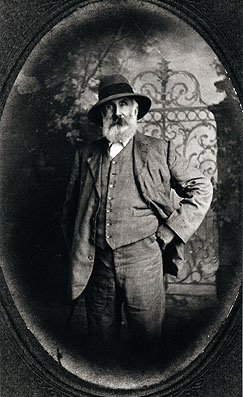
Thomas Henry Cunningham circa late 1890s - Bairnsdale Vic.
BRIEF EARLY BACKGROUND
of
THOMAS HENRY CUNNINGHAM.
Our Thomas Henry Cunningham was the grandson of James and Bridget Cunningham from County Roscommon in Ireland in the 1780s, and second son of Peter Cunningham and Frances Craig, born in Ancoats Manchester UK, on 12th Aug 1835.
Follow this link for more details of the
Ancestry of Thomas Henry Cunningham
and his 4 siblings and parents from 1781 in Roscommon in Ireland.
Thomas Henry Cunningham joined the British Merchant Navy at the age of 15 at Liverpool, following the footprints of his elder brother of 5 years Charles Cunningham. Records indicate brothers Charles and Thomas Henry Cunningham resided together when in port at Liverpool.
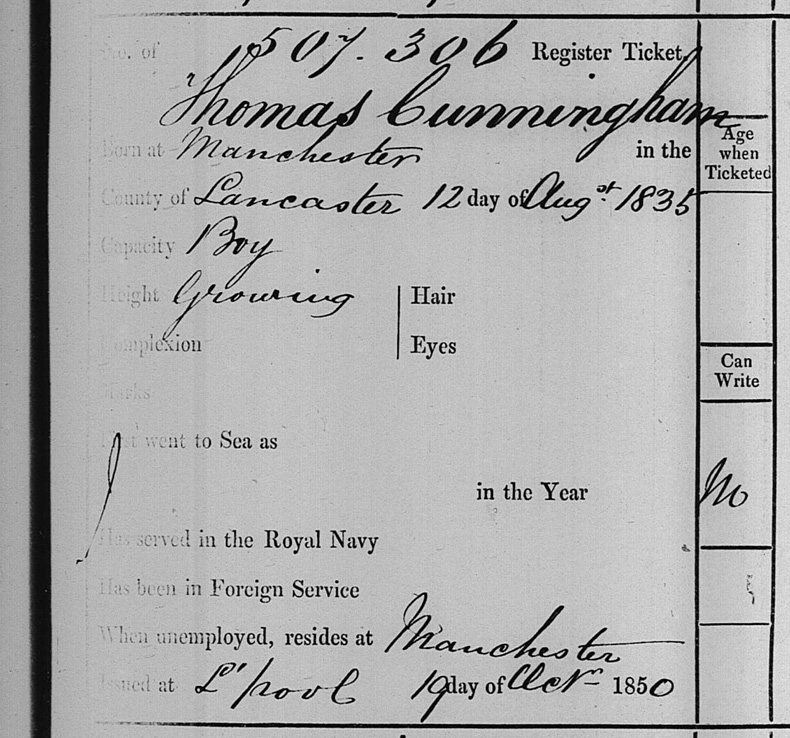
Thomas Henry Cunningham's registration in the British Merchant Navy in 1850.
After spending some time in New York and Philadelphia, and also becoming a US citizen in 1857, at the age of 23 Thomas Henry moved to Melbourne early in 1858, where he commercially bred draught horses, and also held a "Carriers License" required to deliver goods as a Drayman. In Aug 1860 he went by boat on board the Pioneer to Two Fold Bay ( Eden ) in New South Wales, most likely attracted by newspaper reports of major gold finds at Kiandra, about 180 klms north west of Bombala. Early in the 1860s he met Margaret Murphy from Kiandra near the Snowy River, and they had two children together near Bombala, between 1864 and 1869.
Around July of 1864, he attained a substantial tree felling contract needing 40 timber fellers for major road building project of over 100 klms, from Bombala to the coast near Eden. According to reputable family folklore, Thomas Henry had a bad bronchial complaint, and he was advised by his doctor to relocate close to the coast. So with all their belongings and two children on two packhorses, Thomas and Margaret moved to, and selected land on the Tambo River north of Swan Reach in Victoria in 1870, where they had another eight children together.
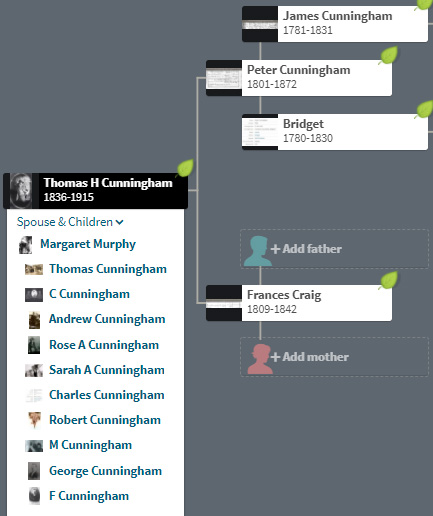
Chart of Thomas Henry and his wife Margaret Cunningham and their 10 children - Courtesy Ancesty.com
Thomas Henry Cunningham Jnr, Born 1864 Bombala NSW, Died 1946 Bairnsdale Vic.
Married Mary Ellen Liddell from Nicholson and had 5 children.
Catherine Cunningham, Born 1869 Jones Corner via Bombala NSW, Died 1907 Lakes Entrance Vic.
Married William Ward from Swan Reach and had 6 children.
Andrew Arthur Cunningham, Born 1872 birth reg Lucknow Vic, Died 1951 East Gippsland, buried Bumberrah Vic.
Married Lillian Emily Beaton nee Brown from the USA and had 2 children.
Rose Ann Cunningham, Born 1873 Tambo Upper Vic, Died 1953 Sale and buried Bumberrah Vic.
Married Walter James Terrill and had 7 children.
Sarah Ann Cunningham, Born 1875 Bairnsdale Vic, Died Swan Reach Vic 1958.
Married William Coulson Calvert Liddell from Nicholson and had 9 children.
Charles William Cunningham, Born 1877 Bairnsdale Vic, Died 1943 Claremont Western Australia.
Married Mary Agnes Kindelan from York WA, and had 3 children.
Robert James Cunningham, Born 1879 Bairnsdale Vic, Died 1970 Preston Vic.
Married Eliza Margaret Holmes from Mt Koorong Vic, and they adopted a Very Catherine ? from Cape Clear.
Margaret Cunningham, Born 1882 Tambo Upper Vic, Died 1975 Bairnsdale Vic.
Married William Joseph Byrne from Swan Reach, and had 7 children.
George Earnest Cunningham, Born 1885 Tambo Upper, Died 1959 Bairnsdale Vic.
Married Isabella Mary Bodelia O'Shea from Walhalla, and had 2 children.
Frederick Stephen Cunningham, Born 1888 Bruthen Vic, Died 1941 Bairnsdale buried Bumberrah Vic.
Married Bridget Sophia Yapp from Omeo, and had 4 children.
Further details and info re, please refer to
The lives of Thomas Henry and Margaret Cunningham, and their 10 children.
Being a busy father of ten children and solid family provider, horse and cattle breeder, cream producer and maize grower, somehow Thomas Henry also managed to find the time for some worthwhile community development projects.
In March of 1878 he arranged a petition signed by a few dozen local residents, and successfully lobbied the Victorian Minister of Education for provision of a local school and teacher, and is also known to have been a major fund raiser for a new wing at the Bairnsdale Hospital around the 1890s.
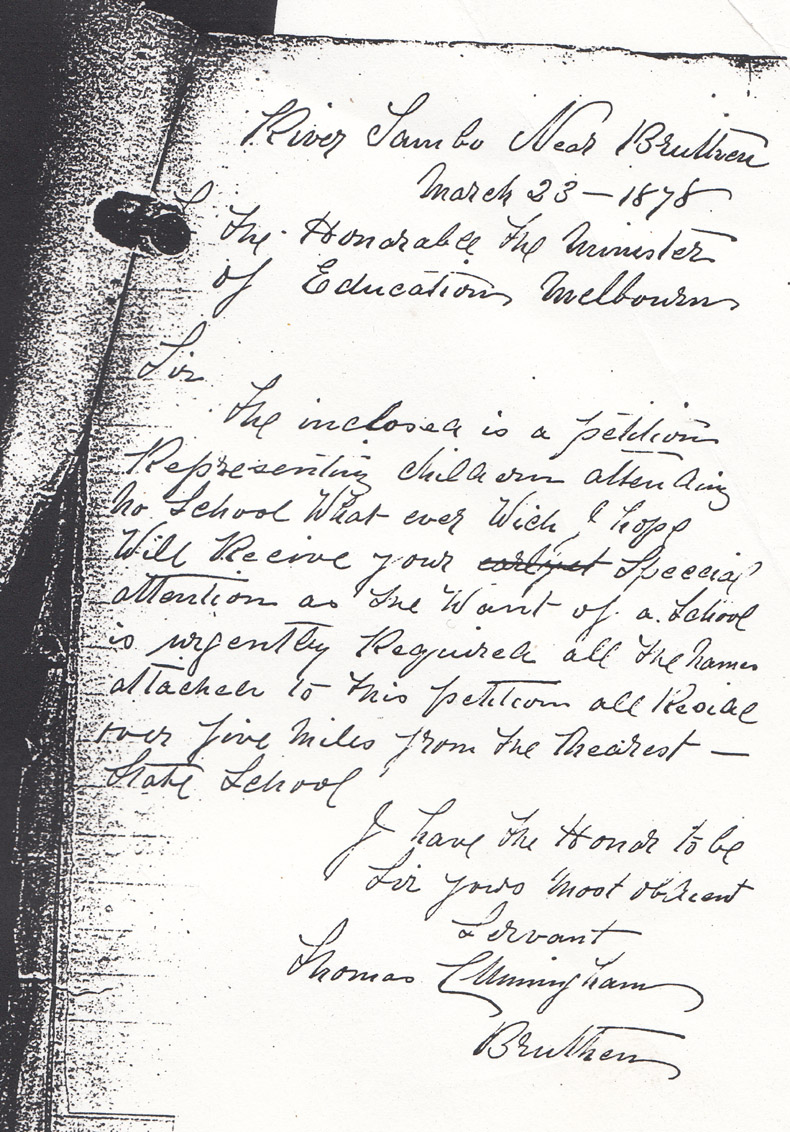
One of many documents Thomas Henry Cunningham submitted for a new local school in the late 1870s.
THOMAS HENRY CUNNINGHAM'S
DIRECT PERSONAL CONTRIBUTION
TO LAKES ENTRANCE VIC.
The documented evidence as outlined in the transcriptions Thomas Henry Cunningham's diary below of the early 1870s, definitely confirms our Cunningham family folklore, that he played a substantial and very personal role in the community and regional development of Lakes Entrance. It was a rarity to find many pioneers around the 1870s who could actually read and write, however Thomas Henry Cunningham kept a small pocket size notepad to record his daily work notations and purchase of supplies, in particular, when he was out working felling trees in the bush. Numerous transcriptions from Thomas Henry Cunningham's personal diary notations of the early 1870s are detailed further below.

One of Thomas Henry Cunningham's saws, found in the shed at his Sunny Hills property near Tambo Upper - c1995 courtesy Mixo Sydenham.
Although Thomas Henry's grammar and phonetic spelling often leaves a bit to be desired, the overall picture he portrays is quite descriptive and informative of his long hard days felling timber, in what was then relatively pristine forest, often around Lake Bunga and Lake Tyers, and at times as far away as Nowa Nowa. Tracing his workmates and regular acquaintances from back in the 1870s has been a rather tedious task, but wherever possible, additional information that has been located, is included for the readers benefit.

Thomas Henry provided bullock dray loads of custom pylons for this construction project in 1872,
to open the Lakes system to the ocean. - Courtesy Lakes Entrance Regional Historical Society.
The period from just after Christmas of 1871 through to early March in 1872, spans the time frame Thomas Henry was hired by a regional contractor John Carpenter from Maffra, to fall and split timber for the making of the initial entrance from the ocean to the Gippsland Lake system at Cunninghame, now known as Lakes Entrance. For this contract, Thomas Henry's diary outlined how he worked and camped in the bush near Bunga Creek, which was nearly a days walk, or about an hour on horseback, from his Sunny Hills property on the Tambo River. The second segment covers nearly a fortnight of entries of January and February in the following year working the bush near Lake Tyers and Nowa Nowa.
There are a number of anomalies surrounding John Carpenter's early efforts to construct a reliable and safe shipping opening from the ocean to Lakes Entrance, free of sand bars and tidal blockages. The Victorian Heritage Database states "The first attempt in 1870 failed, but the "new works" undertaken between 1884 and 1889 completed the task."
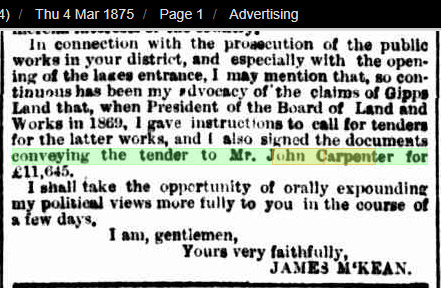
Confirmation of Tender for 11.645 pounds to John Carpenter towards the opening of Lakes Entrance in Mar 1875.
According to numerous newspaper reports in Gippsland Times, The Bairnsdale and Tambo and Omeo Chronicle, and the Melbourne Age of this era, John Carpenter was successfully granted 3 major tenders from the late 1860s to around 1877, to firstly provide suitable lengths of 26 feet averaging around 12 inches wide and 8 inches high, of local red gum, iron bark, and yellow box timber for use as pylons for permanent ocean access at Lakes Entrance. John Carpenters third funding grant was to supply a few hundred labourers and necessary equipment, to dredge and clear the sand after the entrance was opened. It appears our Thomas Henry Cunningham was contracted by John Carpenter to manange a small local timber felling crew, late in 1871, after the first entrance attempt failed, apparently due to regional high tides and floods, and sub standard engineering requirements.
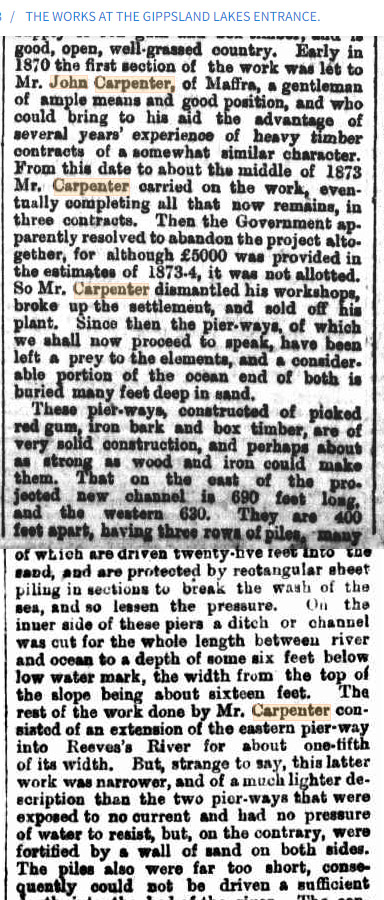
John Carpenter's contract info for his third funding grant. Courtesy The Age via Trove, 1877.
On a more personal family note, according to Ancestry.com records, John Carpenter was the third child of James Carpenter and Elizabeth Tapp, born in 1814 in Tiverton, Devon, UK. John married Sarah Churchward Lee in Victoria in 1864, and had 3 sons and 3 daughters.
John Carpenter appears to have been quite entrepranaurial, as he bought and managed a large flour mill in his home town of Maffra in the 1870, and was also a councillor on the Maffra shire around 1877. John died at Lakes Entrance in 1891.
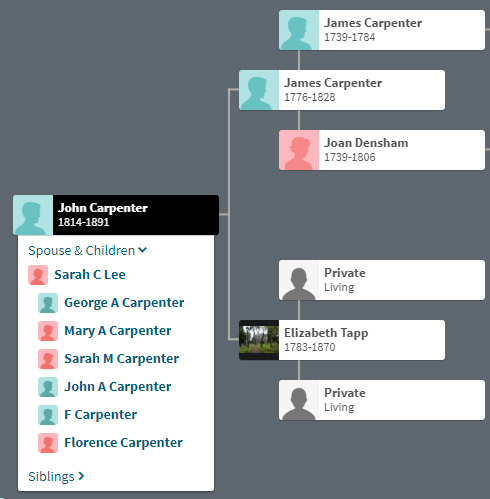
John Carpenter's family chart courtesy Ancestry.com
Thomas Henry Cunningham's diary states he was supplying timber for John Carpenter in 1872, and just to confuse the contracting issue, John Carpenter was granted another tender for constructing the entrance in March of 1875. According to newspaper reports, his 3 sons George, John, and Fred, were all involved in such contracts.
DIARY WORK RECORDS FOR JOHN CARPENTER
From first glance at the two of Thomas Henry's diary pages below here, one may form an impression of his hand writing style and notation system of tallying Mr. Carpenter's accounts, and his own work record of each days accomplishments and comments of events of interest.
The numerals Thomas Henry recorded, are for example,
{ 2 .. 12 .. 8 .. 26 }
indicate the quantities and measurements he supplied as follows:
First digit, 2 represents the number of "piles" ( or pylons ) or logs cut and split.
The second, 12 indicates the width in inches of each split length.
The third, 8 represents the height in inches of each split piece of timber.
The fourth, 26 is the overall length, in feet each log had been trimmed to.
It appears that the standard length for use by Mr Carpenter's lumber was 26 feet or in modern day terms, about 8 & 1/2 metres long, quite a handful of weight to deal with and manoeuvre with the comparatively primitive methods then used in handling and transportation.
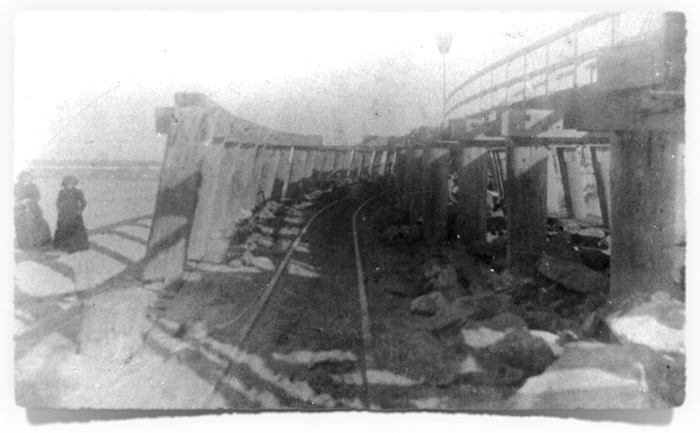
New Works opening to the ocean at Lakes Entrance c1872 - Courtesy Lakes Entrance Regional Historical Society.
THOMAS HENRY CUNNINGHAM'S
DIARY EXTRACTS FROM
27th DEC 1871.
The following 2 images are the only diary entries which were available to copy, during initial researching opportunities back in 1995. They do differ from the subsequent regular daily entries, as they summarise the last 4 working days of 1871, 20 days work in Jan of 1872, and 14 days worked in Feb 1872 until the 17th. The intial page for Jan 1871, details the supplies bought from William Roadknights store on John Carpenters account, for the Thomas Henry's work crew, the amount of timber felled, and what appears to be ledger balance of unknown expenditure of 14 Pounds and 14 Shillings, or $29-80 in current Australian currency.
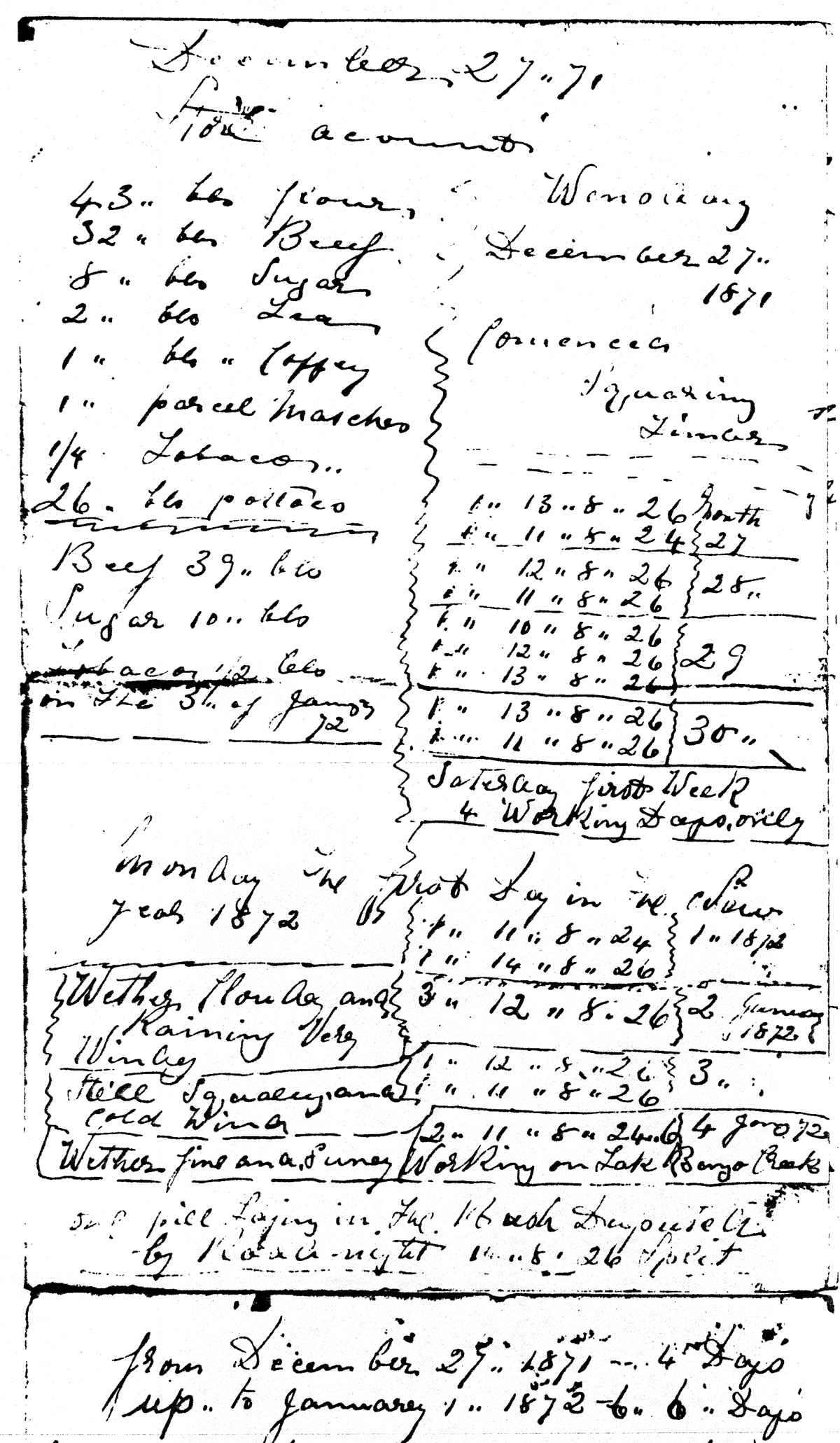
Thomas Henry Cunningham's Diary record, covering 27 Dec 1871 - 4 Jan 1872.
It is not known how many timber feller workers Thomas Henry Cunningham had in his crew, however we do know he referred to his best mate John Kelly, and Nevel ( Samuel Neville ) a number of times. Going by the amount of food and supplies he bought regularly at Roadknights store at Lakes Entrance, it would probably have fed a crew of 3 to 5 workers. Also, it would appear his work pattern camping out bush cutting timber, ranged from 10 days to 2 weeks, and he often only had one day at home with his family, maybe twice per month.
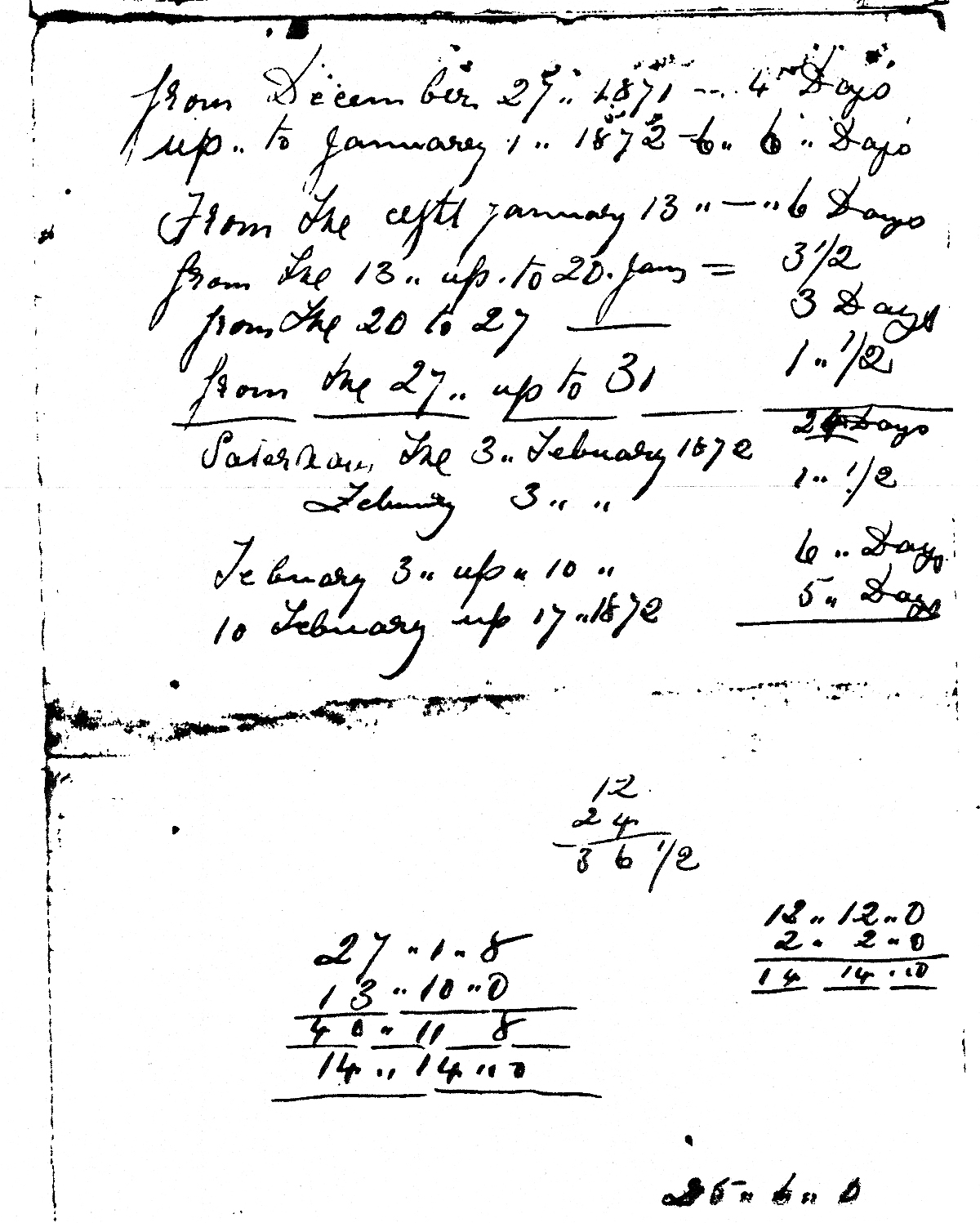
Summary of days worked by Thomas Henry Cunningham's tree felling crew, from Dec 27 1871 till 17 Feb 1872.
4 / 1 /1872
One pille laying in the bush - despatch by Roadknight.
1 .. 14 .. 8 .. 26 split.

Headstone of William Roadknight Snr dated 1893, noted him as "Founder of Lakes Entrance" - Courtesy Ancestry.com
William Roadknight Senior, as noted on his headstone pictured here, was regarded locally as the original "Founder" of Cunninghame, which is now known as Lakes Entrance, situated east of Swan Reach Victoria. William Roadknight Snr. was born in Aldersgate near Whitechapel, London, England on 4th Aug 1813, to William Roadknight and Harriet White. To clarify the above headstone notation, it was William's parents, Harriet and William Roadknight who were actually from Dunchurch in Warwickshire, nearly 9 miles from his place of baptism near Whitechapel.

Birth record of William Roadknight Snr, Aldersgate via Whitechapel London, in Aug 1813.
William Roadknight Senior emigrated to Tasmania with his parents and grandparents Thomas Roadknight and Ann Worth. They eventually resettled at Yan Yan Gurt near Geelong in 1838, and William's younger step brother Zacharia Twamley Roadknight, is reputed in newspaper reports to be the first white child born in Geelong. It appears obvious this William that was the "Oald Roadknight" that our Thomas Henry Cunningham had many personal business dealings with on behalf of his boss, John Carpenter the local timber contractor. Oald William Roadknight was about 60 years of age at this time of the diary.
It is assumed Oald William Roadknight's son William was called and referred to as "Willie" in his childhood, to save confusion in their family household, having two Williams in the same place. In 1844 young Willie Roadknight married Jane Stirling, a 25 year old lass from Glasglow Scotland, before settling at Cunninghame itself in 1859. His brother Thomas, bought the Lake Tyers and Snowy River runs in the 1850's, and ran about a 1000 head of cattle there.
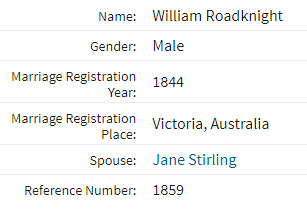
Marriage of Willie Roadknight and Jane Stirling in 1844 - Courtesy Ancestry.com
Many of the family helped to run the Roadknight's general store at Cunninghame, which supplied the few early settlers, bush workers and bullock drivers that frequented the area. The general store supplied a large range of goods and services for the residents of Cunninghame, as well as the occasional visitors to the region. It was ideally situated near the start of the old Bruthen Road, on the rim of the township. Their business flourished and grew many fold with the "New Works" at Lakes Entrance which initially attempted to open the lakes system to the ocean in 1870.
Local Parish maps, indicate two of the Roadknight children also purchased two adjoining farming properties near the Vipond families properties, on the outskirts of Swan Reach, about 5 klms from Thomas Henry's home near Tambo Upper. Thomas Henry was distantly related to the Vipond family via the marriage of his grand daughter Sarah Ann Liddell to Jack Richardson, being Ellen Vipond's son.
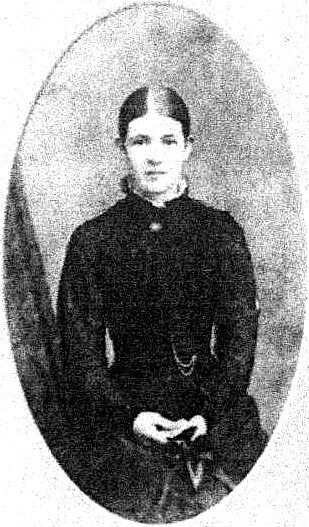
Mrs Ann Jane Roadknight nee Stirling - Courtesy Ancestry.com
Willie Roadknight also served on the Tambo Shire as a councillor for 4 years between 1886 and 1891, according to a chart held by the Orbost and District Historical Society. By the way, the township of Lakes Entrance original name of Cunninghame, is believed to be derived from one of the Cunninghames, Robert or Boyd Alexander, pioneer settlers of Sale and Maffra in the 1840's. Cunninghame the town, was first charted on the Victorian mapping system by its original surveyor, Henry Davidson in 1865. The current backwater behind the main shopping area of Lakes Entrance is known as Cunninghame Arm, a popular boating and fishing area for locals and tourists.

Water colour painting of 1877, entitled "Roadknights from the cottages", by Flora Gregson - Courtesy State Library Vic.
It is worth noting, that funding grants for the initial ocean opening and major developments at Lakes Entrance of this era, included the building of an unknown number of cottages, initially for the benefit of construction workers and local fisherman. In time, after the successful opening to the ocean at Lakes Entrance, these cottages ended up accomodating visitors and tourists to this relatively remote region.
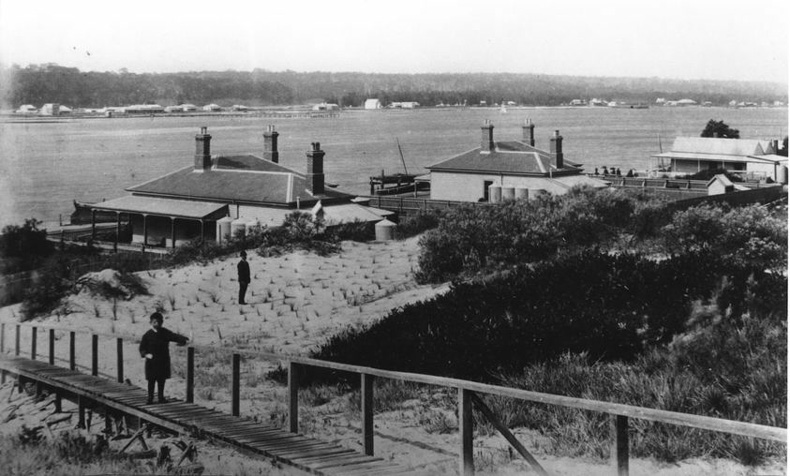
New Works cottages - Courtesy Lakes Entrance Regional Historical Society.
The following overview of the Roadknight family involvements in pioneering East Gippsland, is reproduced courtesy Trove and The Gippsland Times Roadknight family homage of 28 Dec 1933.
"Their family, comprises three sons and two daughters, viz Howard R., Tasman Cecil, Vivian L., Pearl ( Mrs Fallshaw. Sydney ), and Queenie (Mrs
Gaskin, Melbourne ). Mr. Roadknight has lived for 76 years at Lakes Entrance, and has never been absent in that long period for a Christmas or New Year celebration. In 1885 he and his wife took over Marrangbuar House and conducted it as a guesthouse.
The First Railway Engine Brought on a Schooner. When the building of the railway line from Melbourne to Sale was motioned, politicians were anxious for people in Gippsland to benefit by the enterprise, and it was decided to commence the work at each end. It was therefore necessary to ship the material
from Melbourne to Sale and eleven schooners were engaged in this work, and made Lakes Entrance a busy port.
Captain Musgrave was sent with a crew to take charge of pilot operations in 1867, and the schooners were towed in. The Gippsland Navigation Company was then formed and influenced the Government to hand over the work after the Government crew had carried it out for eighteen months. The remains of the schooner, War Hawk, which brought the first railway engine round to Sale, are still lying on the beach opposite Lakes Entrance."
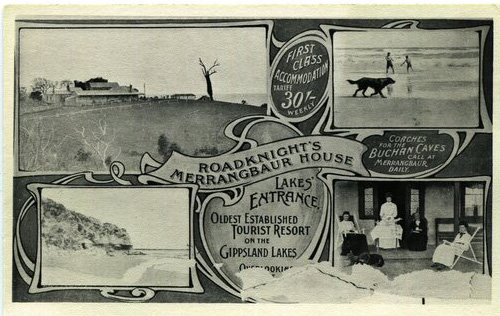
William Roadknight Snr died at what ended up as his son Willies place at Merrangbaur in 1893.
Carried over ... January 5th. 1872 Friday
Wether fine and Sunny
{ 3 .. 14 .. 8 .. 26 }
5th January ‘72
Wether Veary hot and Windy
{ 1 .. 13 .. 8 .. 26 }
6 .. 72 Saterday
{ 1 .. 11 .. 8 .. 26 }
going home on the Tambo River in Company John Kelly my working mate.

Remnants of "Kelly's hut" on Thomas Henry Cunningham's farm "Sunny Hills" - Courtesy Mixo 1995.
It was originally a bit of a mystery at the time the above photo was taken at Sunny Hills, why Jack Cunningham went out of his way to show me what was traditionally known on the Cunningham family farm as Kelly's Hut, yet this diary has since clarified why. It is logical to assume from the above notation by Thomas Henry, about going home in company John Kelly, that Kelly lived on the same property in this very hut as above, while they were supplying timber for John Carpenter's contract. Some 123 years after this diary entry, all that remained of John Kelly's humble abode, are 3 large corner mud clay bricks, and a view of well cleared farming paddocks and some rusty relics looking North East. Jack also metioned that Kelly lived in hut for many years.
Extensive research has surprisingly located records relating to only one John Kelly living in the local area, who was born in 1828, the son of Hugh Kelly and Nancy Mc Neyneld, so if it the same John Kelly noted here, he was about 6 years older than Thomas Henry. John Kelly died in Bairnsdale Hospital in 1903, from "senile decay" according to the Medical Superintendent's report of 4th Apr 1903. No other information whatsoever has yet been located regarding this John Kelly
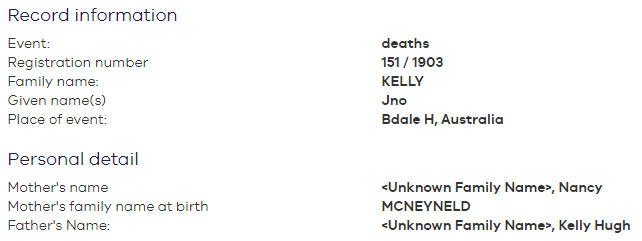
Death record of John Kelly in 1903 at Bairnsdale - Courtesy Trove.
Monday 8 .. of January '72
Left home on Monday at 6 o'clock in the morning arrived at camp on Lake Bunga Bush at 11 am
Removed Lower Down the Creek and Resumed Work
Wether Veary hot and Watter Veary Scarse.
Lake Bunga was about 5 hours walk or half an hour ride on horseback, walking from his Tambo River home in the Summer heat, Lake Bunga being a small lake sandwiched between Reeves River and Lake Tyers. It is interesting to note Bunga is derived from the Aboriginal dialect, meaning, "good clean water". Considering the great local floods of the previous year, Thomas Henry's comment on water being scarce, indicates an extremely long, hot and dry Summer of 1872. Bunga Creek runs from inland a little ways and then under the Princes Highway to the top of the lake. Heavy crude oil was drilled at the junction of the lake and the creek in 1924.
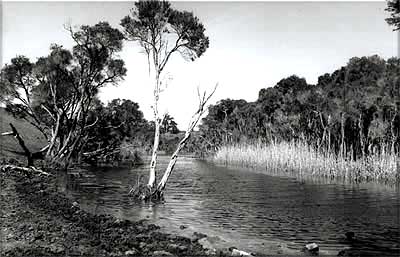
Outskirts of Lake Bunga bush - c1995 courtesy Mixo Sydenham.
Wether Still cloudy { 1 .. 12 .. 8 .. 26 }
8 .. 72
hot 9 .. of month { 1 .. 13 .. 8 .. 26 }
The Dog Stole our Damper
{ 2 .. 13 .. 8 .. 26 }
9 .. 72
Unfortunately I am unable to ascertain for sure which dog is the guilty one in this instance.
Thomas Henry had at least two dogs, "Lucy" and "Darkie",
but Lucy was definitely on the scene two days later.
I am suffering Veary bad from the efects of an boil on the cheek
and on the instep gone to Roadknights for Rations.
Seen the Bullock Drivers.
Wether Still Veary hot and no wind
Beef 31 lbs. Flour 31 lbs. potatoes.
Was speaking to Grants Boys
{ 1 .. 11 .. 8 .. 26 }
{ 1 .. 12 .. 8 .. 26 }
{ 1 .. 13 .. 8 .. 26}
It appears Roadknight's store was a popular meeting place for the regions bush workers, like our Thomas Henry, as well as the Bullock drivers, of the era and area. Another substantial order of supplies indicates that Thomas Henry was more than likely one of John Carpenter's leading hands, probably in charge of a number of men in his crew, labouring felling timber for the "New Works", towards the first man made entrance to the ocean, at Cunninghame, now known as Lakes Entrance. Not all that many Bushies could read or write, keep accounting records, and order supplies on the boss's account, being John Carpenter in those days.
Whether or not the "Grants boys" mentioned here, Thomas Henry was speaking with on this day were the actual bullock drivers he mentions, however it's possible the bullock drivers were some of the Boyd brothers from Metung. George Grant was a Printer by trade, born in Cornwall England in 1824, and had only arrived to settle near Metung about one year before this particular diary notation. Apparently a quite a colourful local identity, ( with a tendency to cuss at his bullock teams ), George foresaw the big demand for transportation in those times.

Marriage of George Grant and Sarah Batten 1853 - Courtesy Ancestry.com
Records as above, show George Grant married a local lass, Sarah Batten, who was also born in 1824, but in Bristol in Somerset England, who somehow ended up living at Swan Reach, near the Tambo River in Eastern Victoria. The Grant boys were George Grant Jnr. ( married Alice Howlett of Swan Reach ), Walter, a boat builder and champion axe man of many competitions, and Edward, who supplied the steamers with timber for fuel by means of a small trolley car on a tramway running down to the Metung jetty. Their sister Marion Grant married Jim Howlett originally from Tasmania, and they had ten kids. The next sister Alice married Edgar Stocks, a well known surveyor at Cunninghame, settling at Nungurner. Along with his sons, George employed the Boyd boys on the bullock runs, (Robert, Albert, Redge and Rupert also from Metung), when times were busy.
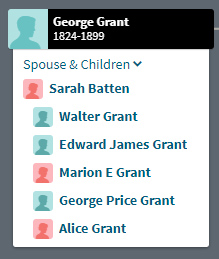
Family of George Grant and Sarah Batten - Courtesy Ancestry.com
George Grant ended up owning Tambo Parish farming allotments No. 75, 75C, and 75D, plus more than a hand full of blocks of land at Metung, including that of the peninsula's tip at Shaving Point. In the 1880's he attained a local mail service contract, established a local primary School, and expanded into a cheese making business around 1910.
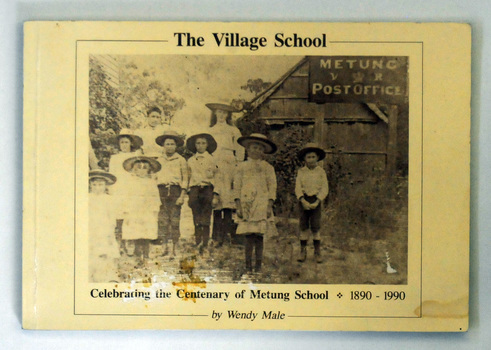
George Grants Post Office and Primary School - C1890s courtesy Trove.
Wednesday 10 of January 1872
1 .. 14 .. 8 .. 26 1 .. 11 .. 8 .. 26 1 .. 12 .. 8 .. 26
Wether Veary Dull and close and tretening Rain
My mate got struck on The Forehead in falling a tree
Only one of the many hazards of working in the bush, which are still possible to occur today.
11 of January Thursday 1872
Weather Dull and Raining
My Dog Lucey caught a Wallaby just after Dinner time
Wich skinned and Brought to the camp.
1 .. 14 .. 8 .. 26 1 .. 10 .. 8 .. 26
January 12 .. 1872 Friday
Carried over ... Saturday 13 .. of January
Weather still Veary Dull and tretening Rain in the morning
Cleared off at miday
Working on the Bruthen Road
finished Three large pilles of the following dimensions
2 .. 14 .. 8 .. 26 ! .. 12 .. 8 .. 26
13 .. 72
The "Bruthen Road" Thomas mentions is what was on old track from near Lake Bunga to Bruthen,
via Colquhoun, a common traveled route of the day.
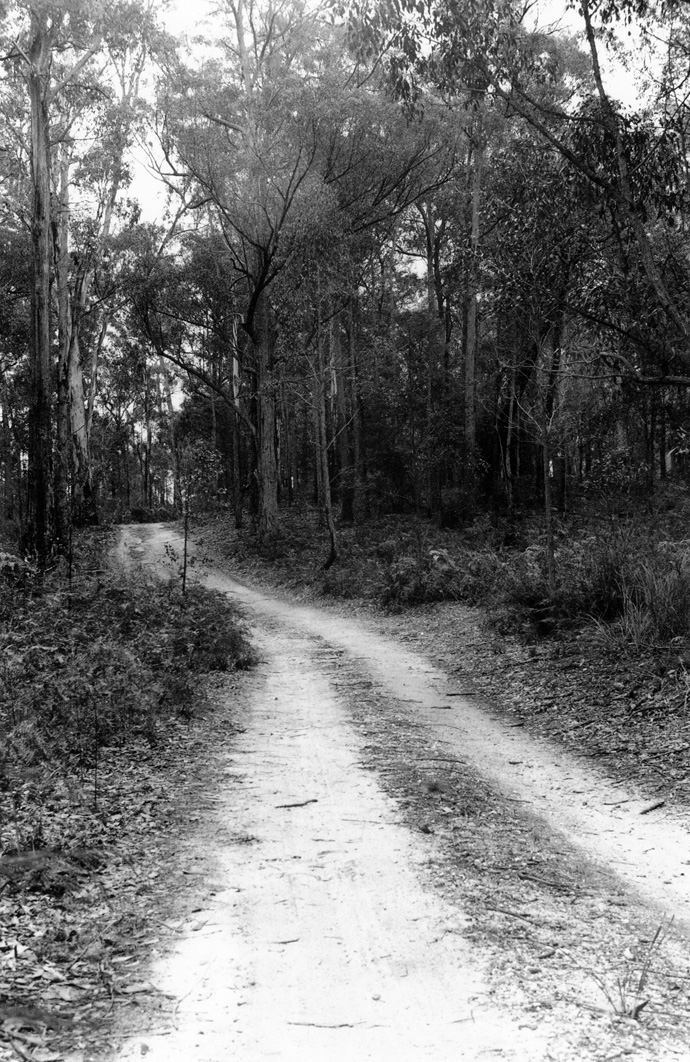
The old Bruthen Road near Colquhoun - c1995 Courtesy Mixo Sydenham.
Sunday 14 January 1872
at the camp in the Bush all morning
Started after on horse Back and called at Roadknights and Seen Willey
and Mrs Roadknight and she invited me in to the garden and gave mee one Green gage to eat
and Speaking to Maden the Bullock Driver and got Sixpence Worth of onions from Mrs Roadknight.
It was probably Mrs. Roadknight Snr that proudly showed Thomas Henry around her garden, and not Willey's wife of about 28 years. To the reader, Thomas Henry's grammar and spelling capabilities often relied heavily upon phonetics, and his cursive script of the name originally transcribed above as "Maden" implies a reference to a James Madden, who lived in and operated a large hotel at Bruthen, in the 1870's.
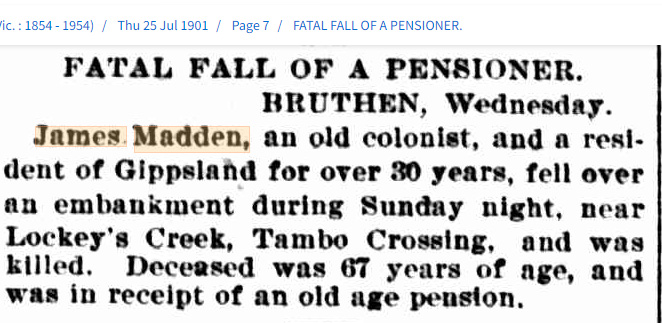
The above shows James Madden was about 37 years old, when he met with Thomas Henry as noted above.
Monday 15 .. January 1872
Weather Veary hot and Close
felled four bad trees and Dressed two Sound ones
I am not feeling Well
hardly able to keep Working having the e cups
Veary bad and sore Throat but got beter in The afternoon
15 / 72
{ 1 .. 14 .. 8 .. 26 }
{ 1 .. 13 .. 8 .. 26 }
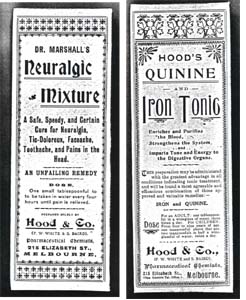
A typical Tonic available in this era.
Maybe Thomas Henry should have listened more often to his grand mother more closely, or go bush with a tonic just in case.
She may have used a great "old wives" cure for the hiccups too.
Tuesday 16 .. 1872
Weather excessively hot
had to Stop Work owing to The extream heat
Went to Roadknights for Rations and had a Swim in the Salt Water
Wich Was Veary Refreshing
felt Veary bad and indiferent in the morning
my mate Kelly Was With nevel
Completed one log.
only 1 .. 13 .. 8 .. 26
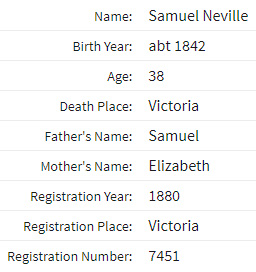
Death record of Samuel Neville of 1880 - Courtesy Ancestry.com
It is probable that "nevel" as stated above, may well have been part of Thomas Henry's regular timber felling work crew. A number of records indicate a local family based in and around Bairnsdale with the surname of Neville, being a Samuel Neville and his wife Eliza Underdown and their two children Thomas Underdown and Gregory, are the most likely "nevel" link in this diary reference. Like Thomas Henry, Samuel joined the British Merchant Navy in 1858 aged 16, and emigrated to Sydney NSW in 1863, and eventually married Eliza in Menindie NSW in 1877. Their son Thomas Underdown Neville, married Alice Victoria Cave, and they raised 5 sons and 3 daughters in Bairnsdale, where Thomas passed away in 1946. This particular Samuel Neville Snr. died quite young in 1880, at the age of 38 at Swan Reach Victoria - Ref 7451/1880. It appears he selected 1000 acres of land at Norimbee near Cann River at some stage.
16 / 72
half day only
one Long Bottle Vinegar
Soda .. acid
8 lbs Sugar
1 lbs Tea
2 lbs Coffey
Perhaps a dip in the salt water was all that Thomas Henry required to clear up the boils of the previous week.
The supplies Thomas Henry acquired on this day, in particular the vinegar and the soda acid could have been
for the making of a remedial remedy of some description, or a concoction for cleaning his tools and / or his gun.
Wednesday 17 .. 1872 January
Weather Still Veary Close
Not able to Work to Day owing to being Seisch With Some Complaint
Late on Tuesday night Wich Resulted in a Sever Vomiting and Want of apetite
Wich myself and my Companion Suffered The same Simtoms Wich Was Veary Distressing on the Whole Sistem
Start This morning in Serch of more Timber but Returned not feeling Well
got to the Camp and made some Supe Wich Wee Both Relished and is now feeling much beter.
Wether Veary Dull and Raining hard and Thundering and has the apearance of Rain all night.
The gonanas is Veary numerous about our Camp and Trubelsome
17 / 72
I suppose being away from the family and comforts of Sunny Hills for ten days, combined with really hard Yacka on a rather basic bushies diet must have eventually taken its toll. One of the few genuine "sickies" Thomas Henry acknowledges appears to have been nicely taken care of by the old traditional feed of soup. It has me wondering if the heightened activity of the Goannas around the camp was aroused by the oncoming storm, or it happened to be something he noticed in one of those rare occasions he had to set down to rest and recuperate, before laying down his sleeping roll. One may also conclude " the Gubbas" or white people had associated with or learnt very little from the local Kurnai aboriginals at that time. A feed of Goanna roasted over an open fire would have provided an excellent feed of meat, cooked in the age old Koorie fashion.
Thursday 18 .. 1872
Weather Veary Dull all Day
Resumed Work again and in good Spirits and feeal alRight
Stoped Work for the Day having Dressed 3 Large Logs
Left my Companion to go Back to the Last tree That I had been Working at having forgot my Coat
my mate going to The Camp took the Rong Way and got Lost and had greate Dificulty in finding him
he having got so far away, Came to The Camp
and Started in Scherch of him and found him by Continually cooeeing
he at last heard mee
he complained of Being much fataged having Walked so far in the tring to find the Camp
18 / 72
{ 2 .. 13 .. 8 .. 26 }
{ 1 .. 14 .. 8 .. 26 }
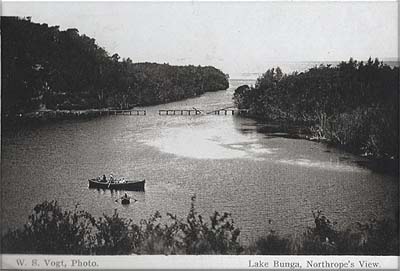
Thanks to Mr Vogt's photo, we know what Lake Bunga looked like
circa 1920's ~ long after Thomas Henry's work crew felled there.
Well ! Just another " one of those days " in the bush for both Thomas Henry and his best mate Kelly, with Thomas Henry leaving his coat behind, and Kelly, totally losing his bearings in the dense scrub. It just goes to show, that even experienced bushies should always follow that golden rule of going bush with some sort of company in case of such situations. Kelly must have breathed a huge sigh of relief when he at last heard a cooee ring through the hills from his pal, after being lost and totally bewildered for so long.
Friday 19 .. 1872
Weather Veary Dull and Close, had four Rotten Trees and Dressed 3 small piles
our meat gone bad
{ 2 .. 11 .. 8 .. 26 }
{ 1 .. 12 .. 8 .. 26 }
19 / 72
N.B. From the last entry, through the channels of time of a hundred and twenty odd years, a number of missing pages creates a bit of a time warp of a couple of weeks. Thomas Henry continues his memoirs from the same area of Lake Bunga, just before heading home to the Tambo.
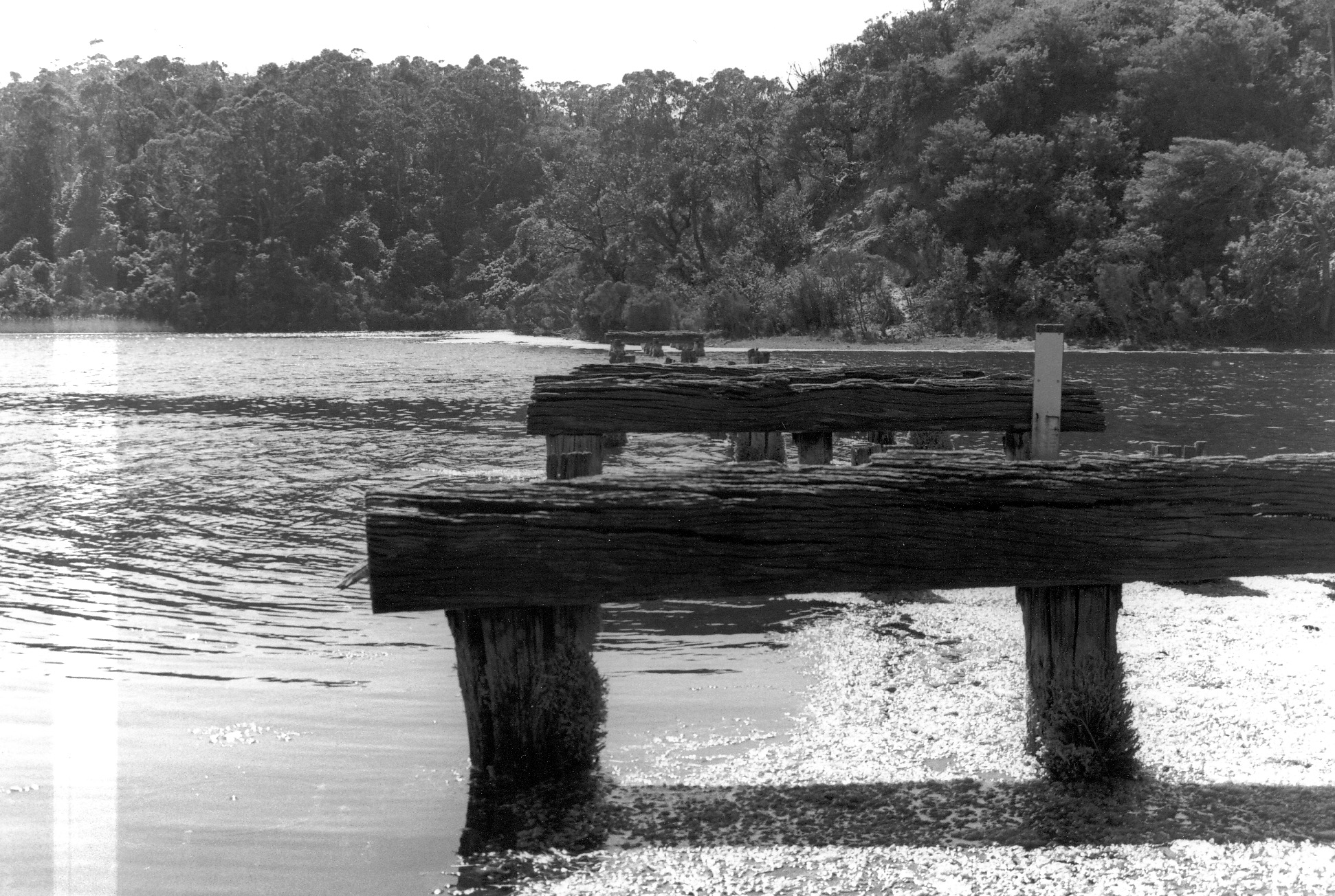
The same bridge Thomas Henry crossed Lake Bunga on his way home - Courtesy Mixo Sydenham c1995.
Saturday Febuary 3 .. 1872
Went to Work this morning
Weather Lookes Veary Dull and treatens Rain.
Dressed the three pilles that Wee fell on the Day previous and fell and Barked another one.
Worked till about 1/2 past 2 oclock. Then came to the camp
had some Tea and then started for home on the Tambo,
tried to Bring a Billy of hunny but could not carry it on the horse Back.
Arrived at home about Dusk
found everything at home all Right
3 / 2 / 72
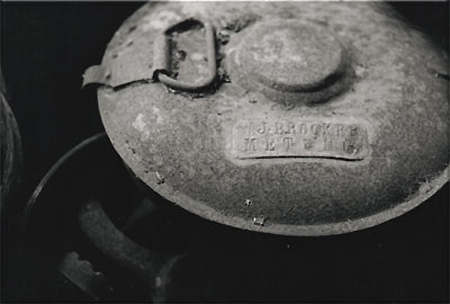
An old Billy found in Thomas Henry's shed at Sunny Hills, labeled "J. Brooker Metung".
Although there appears little or no fixed pattern of his work attendance, or trips cutting timber away from home, the part here "and then started for home on the Tambo", may imply it could have been his first return home within a whole month. The missing entries of the previous fortnight, disrupts the authenticity of continuity of factual interpretation. Apparently bees were transported to the Lakes district about 1867, to instigate a local honey industry, more than likely under the innovative auspices of the Roadknights.
Sunday Febuary 4 .. 1872
Left home about 4 p.m.
arrived at the Camp at Lake Bunga Creek at Dusk.
Seen Smallwood before Wee Left home
my Companion found his knife Whear he left it
the Day he got Lost and was out all night
4 / 2 / 72
Smallwood, although not a common name, research has been unable to confirm any records of a Smallwood in this area in the 1870s, however some references to a Smallwood connection in Lakes Entrance currently exist.
an ******** unreadable ******** s Day
Namely
{ 2 .. 12 .. 8 .. 26 }
5 / 2 / 72.
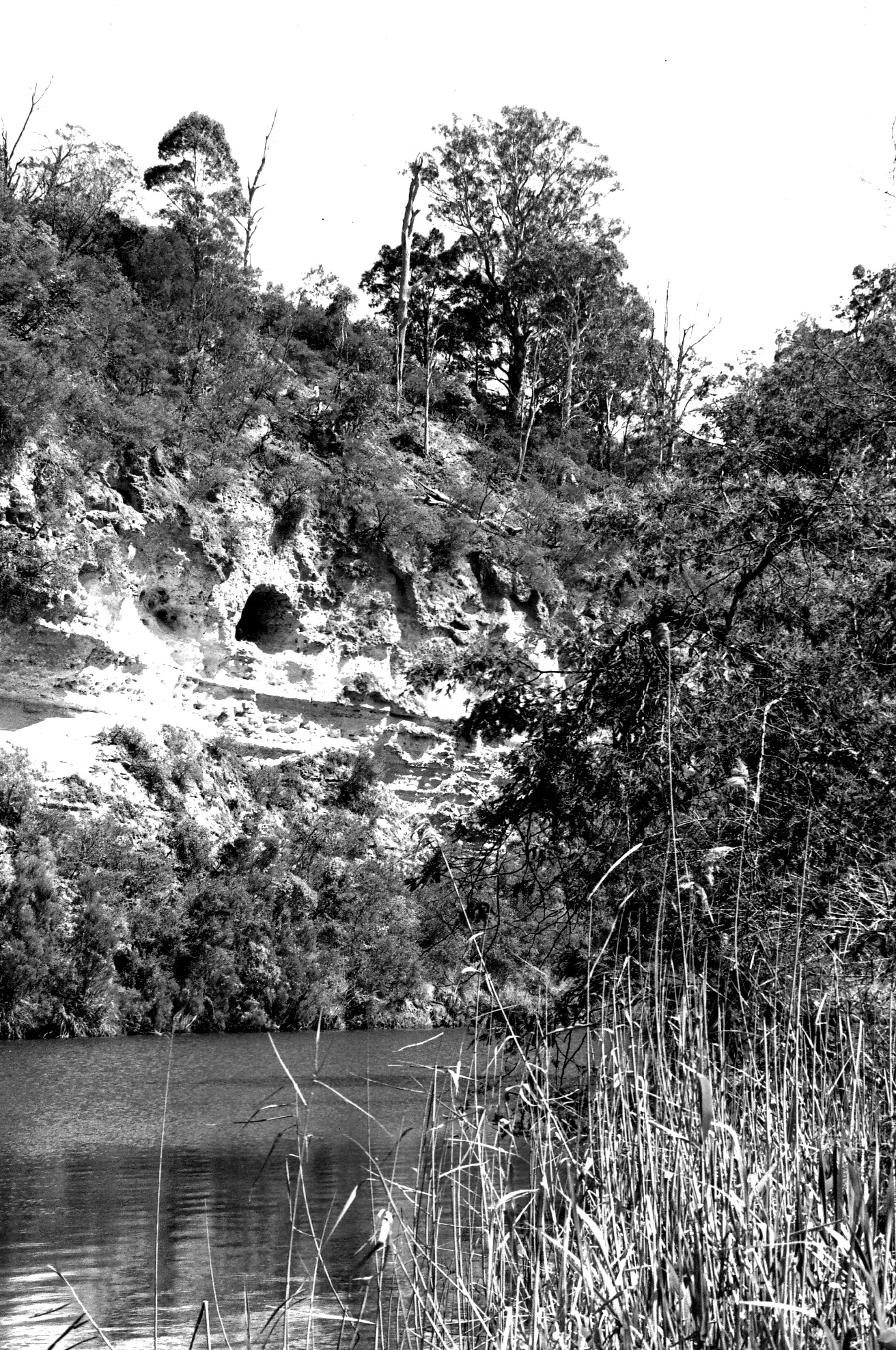
Schmalens Bluff just below Thomas Henry's farm on the Tambo River - Courtesy Mixo Sydenham c1995.
Monday 5 February 1874
Finished Working on the Eastern side of Lake Bunga Creek
Crossed over This Evening and is Working close too Christies Oald hut.
The first that Wee Dressed in the morning split When we had it nearly done s.
That we only Completed too pilles the Day Namely
{ 2 .. 12 .. 8 .. 26 }
5 / 2 / 72
The Eastern side of Bunga Creek near the tip of the actual lake, where Thomas Henry was splitting this pile, is by no means as steep as the other side. Some old hardwood logs still remain abandoned on a steep pinch up from the Western bank on what is now cleared grazing paddocks. The East side of the lake has self revegetated with mainly Banksia, Wattles, but very little Gum or hardwood. Thomas Henry Cunningham and his good mate John Kelly had to go to great lengths hiking up the creek a ways, searching for timber of the proper standard to make the required 26 feet ( about 8 metres )in length.
"Christies oald hut" mentioned here, could have belonged to William Christie, who was originally from East Lothian in Scotland, and later lived at Lucknow, on the outskirts of Bairnsdale.
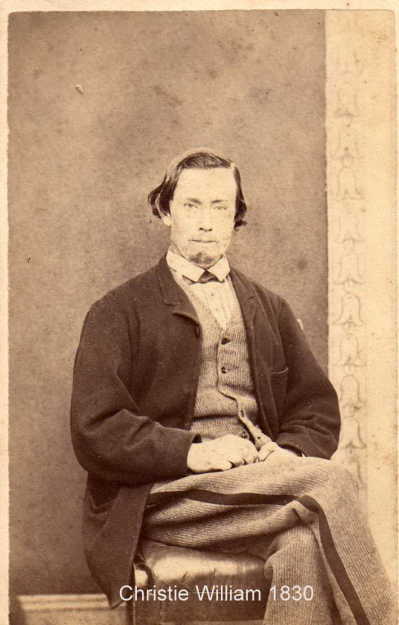
William Christie - Courtesy Ancestry.com
William married Maria O'Hagen, originally from Galway Ireland, in Byaduc Vic in 1866, and they had eight children together. William also had a brother Thomas just to confuse the reader, as per entry on 8 / 1 / 1872, Christies were most likely timber contractors of sorts, and traders in Wattle bark.
Tuesday 6 .. 1872
Droping Dried Timber Wich is Veary hard and tough
Weather Veary fine and me ?? ily warm
Cut into one Rotten tree and Dressed 3 pilles
{ 1 .. 14 .. 8 .. 26 }
{ 1 .. 14 .. 8 .. 26 }
{ 1 .. 12 .. 8 .. 26 }
6 / 2 / 72
Wednesday 7 Febuary 1872
Went too Roadknights for Rations
Seen Mc Dougall and Tom Easton.
Roadknights Refused to give me any more goods on his sons Williams Account
he complained that his son was ?? Paining him.
I gave him an order on Carpenter for 0 .. 17 .. 4 being the amount of Rations optained by me to day.
Left my mate making an axe handell.
Returned and arrived at the Camp about midday
Cooked the Dinner and took to out my mate and Resumed Work and Dressed too Small pilles and part of another
Namely
{ 1 .. 11 .. 8 .. 26 }
{ 1 .. 12 .. 8 .. 26 }
7 / 2 / 72
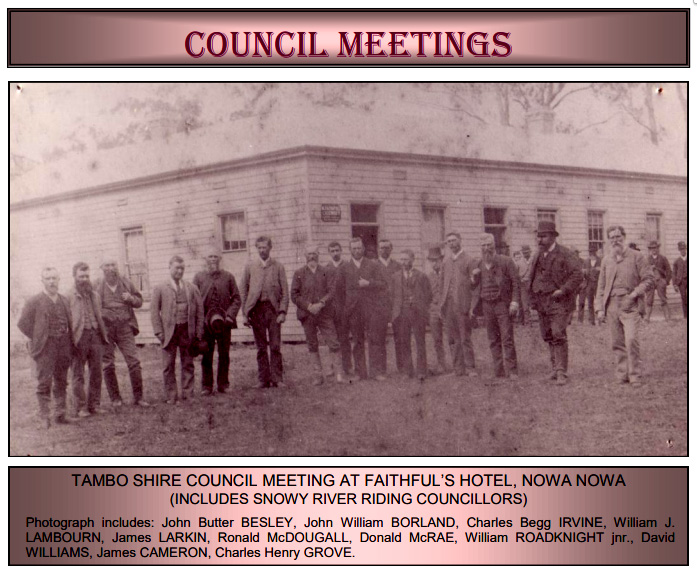
Ronald McDougall - Tambo Shire Councilor. Courtesy Orbost and District Historical Society Inc.
At first observation, the Mc Dougal that Thomas sees on this occasion at Roadknights, I presumed may have been Ronald Mc Dougal of the Bruthen Hotel. However, further research attests Ronald's days were regularly involved in the running of his store in Bruthen known locally at that time as the Tambo Inn. In the year prior to this entry, ( 1871 ) Ronald became the authorized town Postmaster, and is noted in the photo below as a fellow Tambo Shire councilor, along with William Roadknight Junior.
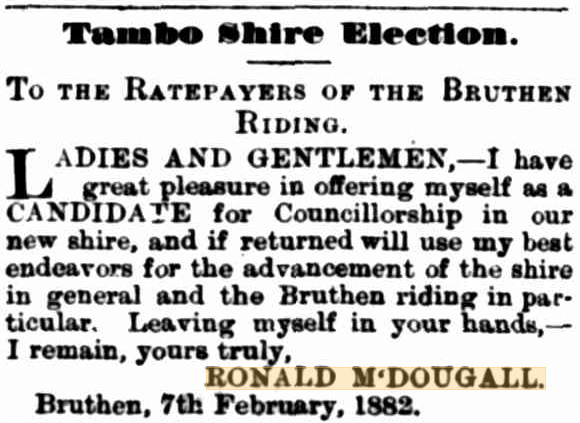
Ronald McDougall was successful in his offer to become a Tambo Shire Councilor in 1882 - Courtesy Trove.
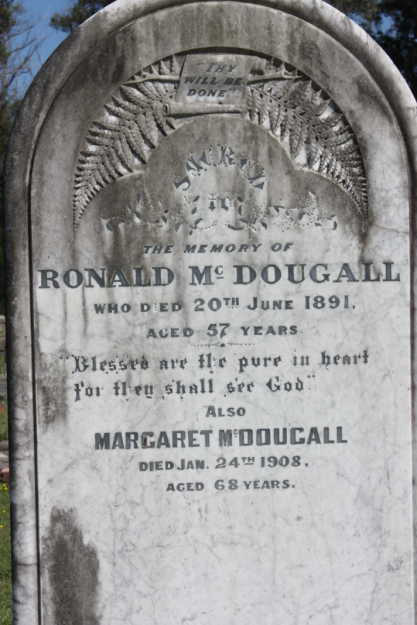
Ronald McDougall died in 1891. Courtesy Trove.
The only other Mc Dougal that I have been able to locate as being in the region is Dougal Mc Dougal, who later turned out to be compatriots along with nearby neighbours Charles Batten, Benjamin Biggs, David Wilson ( and Thomas Henry ) in their successful petition and plight for a new school at Tambo Upper, as per the letter of 23 Mar 1878 as shown above. Even later, in 1903, Dougal purchased land adjoining holdings of Batten and Thomas Henry's nephew, Charles William Ward, located just up the track from Battens Landing.
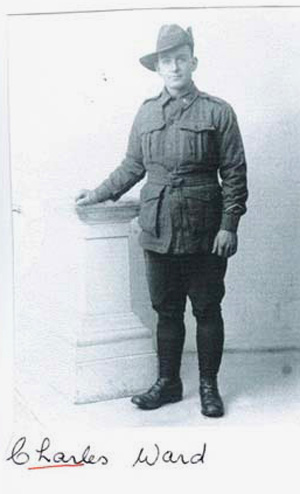
Charles William Ward in days of War War I.
According to Ancestry.com Tom Easton who was born in London in 1834, married William and Jane Roadknight's third daughter, Harriet Vicary Roadknight in her home town of Geelong Victoria in 1872. We may derive no definite conclusion to the purpose of Dougal's visit to Cunninghame on that Wednesday, however, it appears a little clearer as to the motives of Tom Easton for being in that general vicinity. Tom was a long ways from his original home town of London, but I reckon he would have a special glint in his eye when he and Thomas Henry's paths crossed. Little beknownst to Young Tom, a big year was to unfold for him in 1872, apart from the pre nuptials that he was probably discussing with Mr. Roadknight.
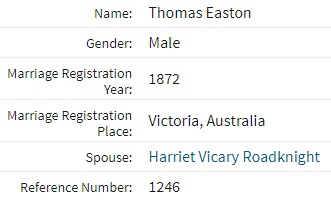
Marriage of Thomas Easton and Harriet Roadknight in 1872 - Courtesy Ancestry.com
For not only in the same year of 1872, did he marry Harriet Vicary Roadknight, but he also managed to secure a much respected position as the first Secretary - Engineer of the newly formed Shire of Omeo. Tom's first major role for the Shire, was the overseeing of construction of the roadway between Omeo and Benambra, which he triumphantly brought in under budget for an extraordinary sum of 800 pounds. Tom Easton had a number of local legal duties, and represented numerous court cases as a local Justice of the Peace.
The Order on Carpenter Thomas Henry wrote for the next weeks rations for his fellow bushies was the equivalent of our modern day cheque or money order of some description, under written authority from John Carpenter.
It is also of some note that Kelly, like many pioneer bushies of these times, was quite handy and very flexible, and most productive with every daylight hour. It makes sense that axe handles worked so hard on a daily basis, and would need regular repairs and replacement, as in this instance. It seems Thomas Henry gave hisn mate Kelly a bit of space and time to complete his task making an axe handle, before returning some time later from camp with a cooked luncheon for his best mate.
Thursday 8 .. Febuary 1872
Working Still close too Christies oald hut
in the bringing the horses too the Camp Lost the hobbles one of them
The Bark Removed by someone from Christies hut
Dressed four pilles of the following Dimensions
{ 2 .. 11 .. 8 .. 26 }
{ 1 .. 13 .. 8 .. 26 }
{ 1 .. 12 .. 8 .. 26 }
Weather Looking Dull
} 8 / 2 / 72
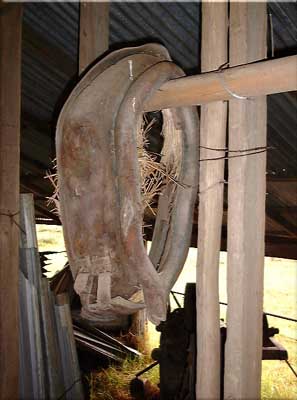
Thomas Henry was well reputed as a top horse breeder.
" Hobbles " are a device, usually made of two leather straps, joined together by a rope or chain, that are fastened around the legs of a horse. The rope is just long enough to permit the horse to slowly move around to graze, yet still inhibits the horse from being able to run or travel too far.
Thomas Henry had a productive day, finishing off four piles.
Friday 9 .. 1872 Feburary
Working too Day The other side of Christies hut
No particular events occured too day
Dressed 3 pilles too Day
Weather fine and Suney all Day but got Dull and overcast in the evening.
{ 1 .. 12 .. 8 .. 26 }
{ 1 .. 14 .. 8 .. 26 }
{ 1 .. 11 .. 8 .. 26 }
} 9 / 2 / 72
Saterday 10 .. Febuary 1872
Weather Veary Dull.
Seen Donaldson and the Bullock Driver
Showed the Bullock Drivers one round pill and Donaldson toald me
that I could Work some of his pilles that too small for Round pilles
finished to pilles and Started for home about midday
arrived at home about 5 p.m. and found everything all right at home
} 2 .. 12 .. 8 .. 26
} 14 in log
10 / 2 / 72
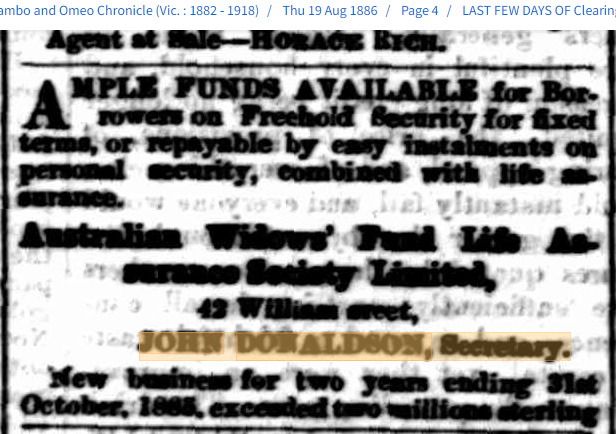
A funding advertisement by John Donaldson in 1886 - Courtesy Trove.
One may assume Donaldson was also a local timber feller, who seemed to have a surplus of Pilles in the same area. Research has located a local by the name of a John Donaldson, who was charged with the shooting of a John Miller earlier in Mar 1864 at Paynesville. In Aug of 1886, according to an advert in the Bairnsdale Advertiser, he was apparently the local secretary for the Australian Widows Fund Life Assurance Society Limited. Thomas Henry had better luck on this day, heading home and spending some time with his family, after a five hour working day.
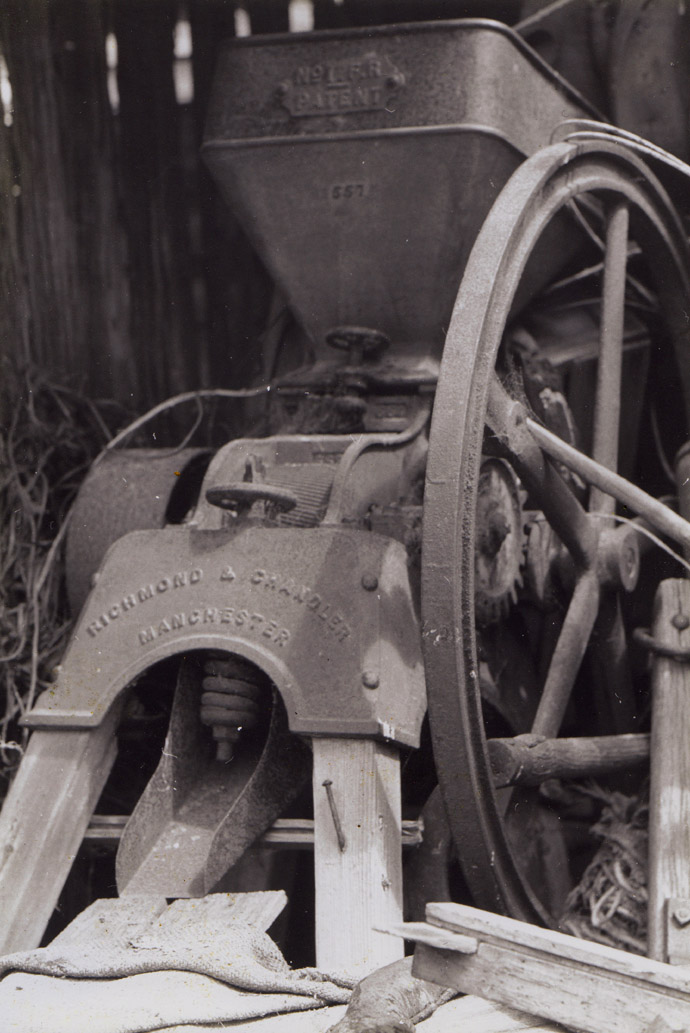
Thomas Henry was born in Ancoats which is only just over one mile from the centre Manchester, so it makes sense his Richmond and Chandler Chaff Cutter was from his home town, as Manchester was the most industrialized city in England of that time.
Sunday 11 .. Febuary 1872
At home all morning
my mate Went too Bruthen for potatoes but optain none
I Went to Mr Pratts in the afternoon and had a Drink of tea thear
and then started to the mills Down the River for Leters of mine
that got miss sent but could not get them
Mr Smallwood stoped at my place Last night.
} 11 / 2/ 72
Pity about the trip all the way to Bruthen and not being able to score a single spud!
Research into numerous newspaper advertisements of the 1880s in particular, outlines a noticable common interest between Thomas Henry and his friend Mr Pratt, being the breeding and sale of horses for many purposes. It appears Mr Pratt had a business partner and together they formed Campbell Pratt and Co, who provided regular local and Melbourne market reports, and had numerous sales and auctions of race horses at Kirks Bazaar in the city.
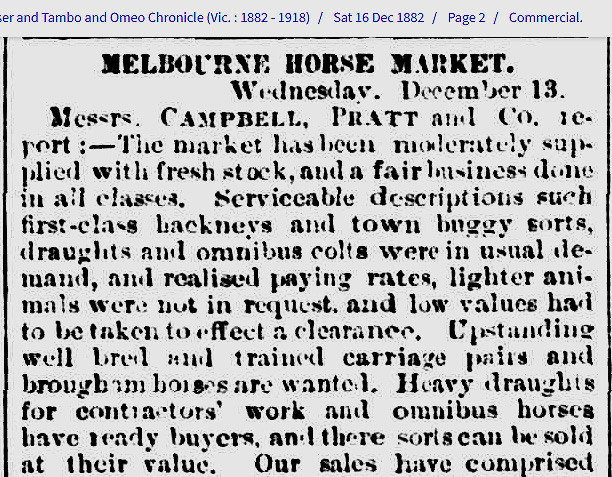
Horse Market report in Melbourne by Campbell and Pratt 1862 - Courtesy Trove.
RE Thomas Henry's letters from the Mill.
The company was also involved in sale of land for subdivision on the Mitchell River, being a 3000 acre property called the Alexlea Estate.
According to the Parish map, Pratts also bought land on the opposite bank of the Tambo to Thomas and Margaret, around the 1920's.
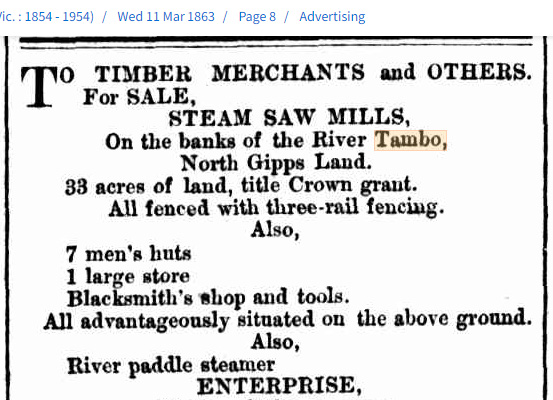
Tambo River saw mill for sale in 1863 - Courtesy Trove.
According to Gippsland newspapers on Trove, the Tambo River steam saw mill, was established in 1859 by McArdell and Raphael. The exact circumstances of events surrounding the deaths of these business partners have not been ascertained to date, however an indenture of assignment and conveyance was noted on their Joint Estate in the Gippsland times on 30 Jan 1863. Going by the above newspaper description of the saw mill and it's sundries for sale back in 1863, the reader may presume it was probably the largest well established business operation and employer in the local district. It's substantial equipment list included a Rankin horizontal pressure engine, a vertical frame capable of handling logs 4 feet 6 inches ( 140 cm ) in diameter, a tram road and truck, and a timber shoot to the wharf.
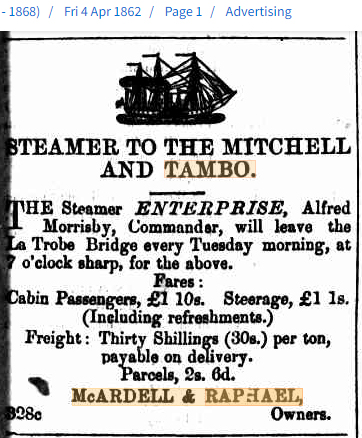
A McArdell and Raphael advert from 1862 - Courtesy Trove.
The PS Enterprise paddle steamer, also owned by McArdell and Raphael, was utilized as a supply vessel supporting gold miners in the Boggy Creek area around 1860, as well as the major means of transporting processed timber to the port at Sale via the Thompson River. Further research indicates Gustav Schnieder has been co-owner of the nearby Wonga Wonga saw mill with William Monger up until Jul 1865, when their business partnership was officially disolved. The Gippsland Times reported Thomas Henry's assocate Mr Schnieder opened his new saw mill on the Tambo on the 25th Jan 1870, and the steam engine was christened and first tested by Mrs Day, whose husband Joseph was a timber contractor, storekeeper, and manager of the Miners Arms public house at Omeo.
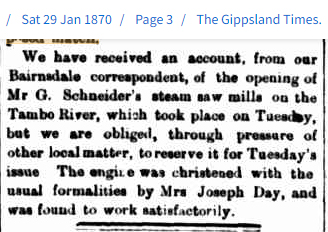
Opening of Mr Schnieder Mill in 1870 on the Tambo River - Courtesy Trove.
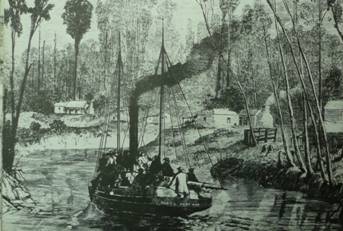
The PS Enterprise on the Tambo River circa 1880's - Courtesy POI Australia.
Because there was no official postal service until much later at Swan Reach, Thomas Henry may have utilized Mr Schnieder's mill as his mailing address for some time, being a wee stroll a few miles downstream from Sunny Hills. This particular mill was virtually located adjacent to the old landing where the Tambo punt used to pull in on the Eastern bank at the Swan Reach township, right next to where the current highway bridge stands. By the way, the Post Master Generals Department established a delivery contract with Jim Foley about 1880, from Bairnsdale through to Cunninghame, the actual deliveries were made on horseback.
Monday Febuary 12
Left home
Removed the Camp horses to the Bruthen Road
I Went for Rations to Roadknights.
no pilles Dressed to Day
20 lbs beef
2 lbs Coffey
8 sugar
12 / 2 / 72
Comenced Drawing pilles
As leading hand, there is always the responsibility of catering for the workers. Another new week finds Thomas Henry organizing the basics getting set up for work.
Teausday Febuary 13 .. 1872
Weather Veary Dull all morning but cleared in the afternoon
Comenced Work to Day
Dressed Three pilles , expected the Bullock teams too Day but they did not come
{ 2 .. 12 .. 8 .. 26 }
{ 1 .. 13 .. 8 .. 26 }
} 13 / 2 / 72
Wensday 14 Febuary 1872
Weather Veary Dull all Day
Rookes and madan and the Waragall had Dinner With me and my mate.
I Showed Maden and Rooks all my pilles
Dressed only one pille
1 .. 11 .. 8 .. 24
} 14 / 2 / 72
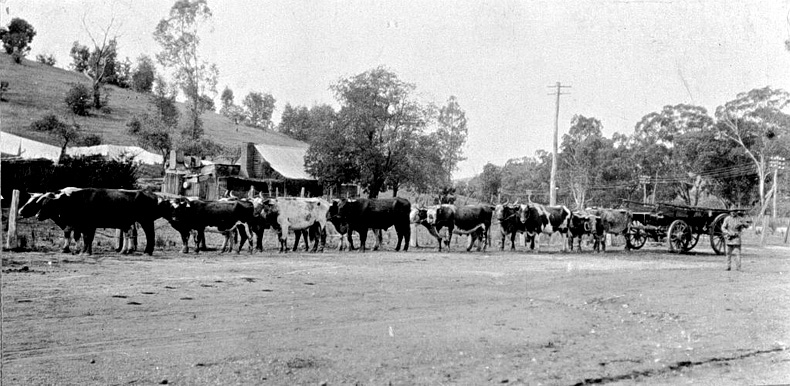
A typical Bullock team passing through Omeo - Courtesy State Library of Vic.
Thomas Henry's spelling of proper nouns did not improve - The Rooks ( without an e) could only have been Joseph Rooks, a neighbour of Thomas Henry's boss John Carpenter. Rooks was a bit of a local identity, carting stone and timber with his numerous bullock drays. He traveled far and wide hauling freight, from near his home not far from the Nicholson's riverbank, possibly as far as N.S.W.. A popular stopover for bullockies on the way north was simply called Rooks, at the base of Black Mountain, which may have been linked to Joshua in some respect.
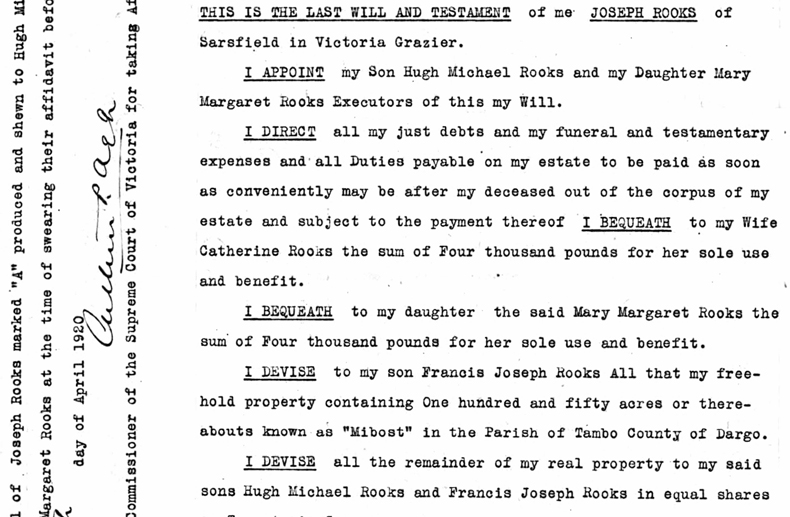
Will extract of Joseph Rooks - Courtesy Ancestry.com
Mr Rooks also had a big year in '72, being the year he married Catherine Mc Namara of County Clare in Ireland. They had three children, Margaret Mary in 1873, Francis Joseph in 1875, and Hugh Michael in 1877. Joshua held at least ten land titles of varying shapes and sizes around the Nicholson River, and its backwash just South of Sarsfield. Joshua passed away in march of 1920 and is buried at Bairnsdale cemetery.
"The Waragall" must have been a nick name for an aboriginal acquaintance, as this is a locally used term that was originally used for the so-called "wild aboriginals", whom had had little or no contact with the white invaders of their country. However, it is clear from later notations that Thomas Henry did have some contact with local aborigines at the settlement at Lake Tyers, which he referred to as the Blacks Station.
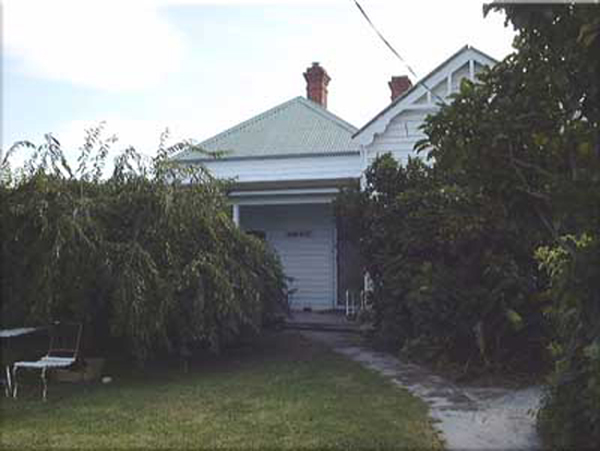
The "Sunny Hills" home ~ 2001.
Thursday 15 .. Febuary 1872
Weather fine and hot all Day but Veary Cloudy and Dull in the evening and treatening Rain
Dresses four pilles too Day
namely
{ 1 .. 14 .. 8 .. 26 }
{ 1 .. 11 .. 8 .. 26 }
{ 1 .. 12 .. 8 .. 26 }
} 1 - 1 .. 12 .. 8 .. 24
15 / 2 / 72
The next day for Thomas Hanry's felling crew was a big day Dressing four piles
Friday 16 .. 1872
to Day Veary hot and the timber Veary hard.
Dressed Three pilles
one turned no good after being half Worked and one Split after being Nearly finished
the Last that Wee are at is exceedingly hard
{ 3 .. 14 .. 8 .. 26 }
} 16 / 2 / 72
Saterday Febuary 17 .. 1872
This Day has been exceedingly hot.
Dressed four pilles and fell another one Wich turned no good The timber is geting Veary Scarce indeed
Stoped Working about miday
my horse went home
I Walked about half Way home Looking for him but could not find him
my Companion Lent mee his horse to go home with
he preferred Stoping.
Start home about 3 p.m.
arrived at home about 6 p.m. and found everything at home all Right and my family all Well and in good health.
17 / 2 / 72
Thank God for it !
{ 1 .. 11 .. 8 .. 24 }
{ 1 .. 12 .. 8 .. 26 }
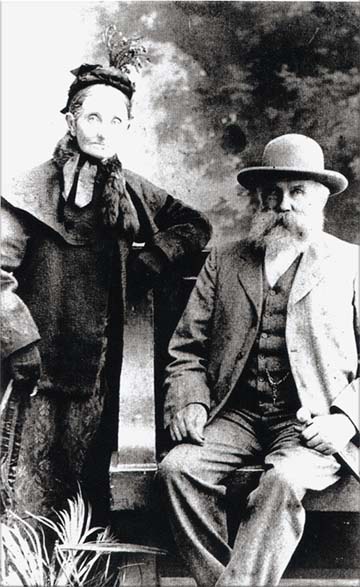
It is envisaged Thomas Henry would be very glad to be home with his wife Margaret and their children ! Margaret was heavily pregnant with their third child Andrew Arthur, who was born in March of 1872.
Every experienced timber feller who has worked in summer from East Gippsland or Far North Queensland, so can relate only too well to Thomas Henry's reasons for knocking off work at midday on this stinker of a day. Finding time to fix or replace a set of hobbles would have been difficult with so much work on the go in the bush. When things just aren't quite happening as they should, like your means of transport leaving without you, then it's just as well to call it quits. Margaret would have been gravely concerned when Thomas Henry's horse arrived at Sunny Hills without a rider !
**** unreadable **** the afternoon
Sunday Febuary 18 .. 1872
at home all Day till about 4 p.m When Mr Schineder called at my place and I Went With him to the milles and from thear to Swan Reach Station and While I am Stoping thear my Dog Darkie thear that was Stole from mee Some time ago
I took possesion of him and Brought him home With mee.
18 / 2 / 72
Thomas Henry's long lost hound Darkie finally turns up and takes his rightful place back at home again. Although a stern man at times, he loved animals, and in particular, bred many fine horses. But fancy a person like Mr Schnieder interrupting Thomas Henry's usual Sunday afternoon off work. Gustav Schnieder, an experienced sawmiller of the district, had managed a couple of large sawmills for at least eight years by 1872. He opened a brand new steam powered mill in 1870 just prior to the Cunninghams arrival at Swan Reach. Gustav also built two steamships, the Frolic and the Mary Ann in the same year.
An extremely busy business person, he also had family responsibilities. Gustav had married Mary Gibbs back in 1863, and by 1872, the fourth of his five kids Francesca was born. The eldest daughter, married Charles Redenbach, one of Thomas Henry's neighbours children, in 1885.
Monday Febuary 19 .. 1872
Left home This morning at 7 a.m.
arrived at my Camp about 10 a.m.
found my mate at Work
proceeded to Roadknights for Rations as thear Was no beef at the Camp
Went and Branded some pilles in the afternoon and met the Bullock Drivers Drawing Them Together
no pilles Dressed to Day
my mate falling and Blocking off by himself
19 / 2 / 72
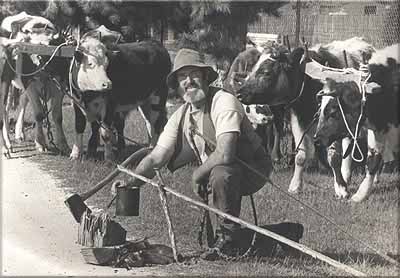
Genealogically, it make sense that nearly 120 years later, there is
still interest in bullocks running in the Cunningham blood.
Thomas Henry's Gt Grandson Allan [ Curl ] Cunningham.
Monday morning and it's back to work for the bush gangs. Each pile ( or log ) was split almost up to the head of the tree using an axe and wedges, after it had been "blocked off", or cut to the required length with a cross cut saw . The idea of leaving each log in one whole piece, rather than numerous small split rails was to reduce handling time, loading and carting by the bullockies. It was then branded or marked with the worker's name in order to facilitate the keeping of records back at the mill, to ensure payment to the correct bushie. The bullockies arranged their teams in such a way to haul the huge logs on to their wagons using a series of heavy chains. Upon arrival at the mill, the piles were unloaded and positioned carefully over a sunken sawpit, enabling final splitting and processing for its required purpose.
Teausday Febuary 20 1872
My mate Still Working by himself as I am helping The Bullock Drivers to put the pilles together
gave maden an order on Carpenter
no pilles Dressed by me to Day.
20 / 2 / 72
Wensday 21 1872
Sufering from a Sore eye
had to Stop Work
Dressed only one pille
14 .. 8 .. 26
Brought 8 lbs Beef from Roadknights
21 / 2 / 72
Thomas Henry really liked a good supply of meat readily available. Somewhere around the turn of the century, according to Jack Cunningham, he established a butchers shop at Lakes Entrance, managed by his son in law Bill Ward.
Thursday 22 Febuary 1872
my eye is now beter
helped The Bulock Drivers to Load
Returned and Dressed 3 Small pilles my mate has bad Luck in falling Rotton timber
{ 3 .. 12 .. 8 .. 26 }
22 / 2 / 72
Friday 23 .. 1872
Dressed two Small pilles only to Day
my mate is falling Veary Small timber hardly Big enough
helped The Bullock Drivers to Day
{ 1 .. 10 .. 8 .. 24 }
{ 1 .. 12 .. 8 .. 24 }
23 / 2 / 72
Saterday 24 1872
got on Veary badly
finished four Small pilles
no meat to Day and none to be got at the Butchers
} 3 .. 12 .. 8 .. 26
} 1 .. 13 .. 8 .. 26
} 24 / 2 / 72
Sunday Febuary 25 .. 1872
Did not go home on Saturday as usual
Stoped to finish of
my mate at the Camp all Day
I Went in Search of meat but Did not get any
got some fish from Jimmeys point and one Duck
Returned to the Camp about Dusk
25 / 2 / 72
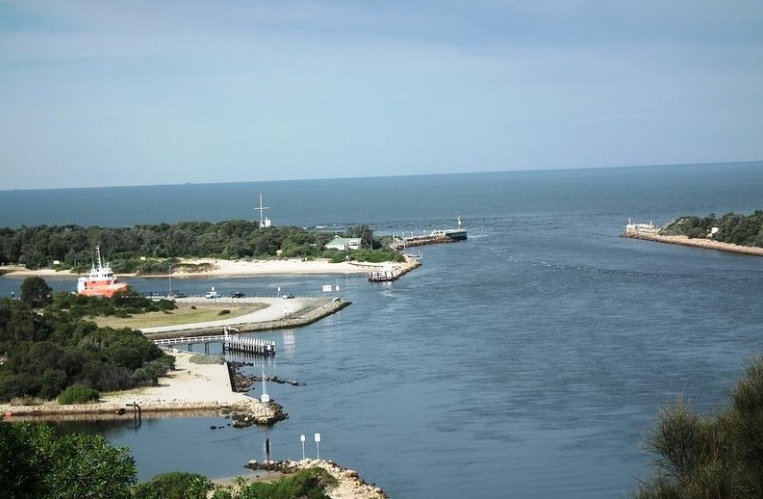
Current view of the ocean entrance from Jemmys Point - Courtesy Trip Advisor.
Jemmys Point is the tip of the headland where Reeves Channel and Cunninghame Arm meet, directly above Bullock Island. The township of Kalimna basks in the majestic views from high above this point, at what turned out to be registered as a light house reserve in those days. It overlooks the man-made entrance that Thomas Henry and his fellow bushies worked and sweated so hard to provide much of the materials that went into producing the original two stages of the project that were managed by John Carpenter.
Monday Febuary 26 .. 72
Compleated four pilles to Day and fell another one Wich is the Last one
1 .. 13 .. 8 .. 26
2 .. 12 .. 8 .. 26
} 26 / 72
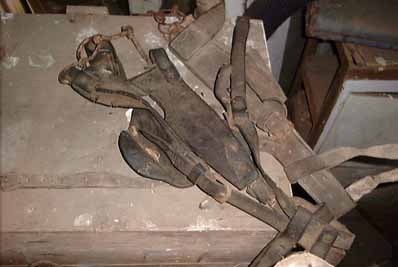
Some old leather horse gear found in his shed.
Teausday Febuary 27 1872
my mate gone for the horses
Compleated all my Work
I finished one Large pille and helped The Bullock Drivers to Load
and Went Down to the Waters edge With them and Stoped all night and Will Return to morrow
1 .. 14 .. 8 .. 26
Wensday Febuary 28 1872
Returned with the Bulock Teames and helped Rookes to Load and Then Went
to The Camp and found my Mate had Returned With The horses and was packing up
Wee Both Went down to Roadnights and Then Started for the tambo and arrived about 10 pm
gave Roadnight an order for the Rations Account 28 / 2 / 1872
Thursday at home
Febuary 29 1872
At home and doing nothing
Kangarooing in the Afternoon
29 / 2 / 1872
A rare day of comparative rest at home on the Tambo River !
Friday March 1 , 1872
at home to Day
Burning off the Bush
no transactions of note passed to Day
1 / 3 / 72
Saterday March 2 1872
at home Doing nothing particular
my mate Still With mee
2 / 3 / 72
Sunday March 3 / 72
At home to Day allso Till Evening When me and my mate Went
to The Sawmill Down The River and Returned about 8 p.m.
3 / 3 / 72
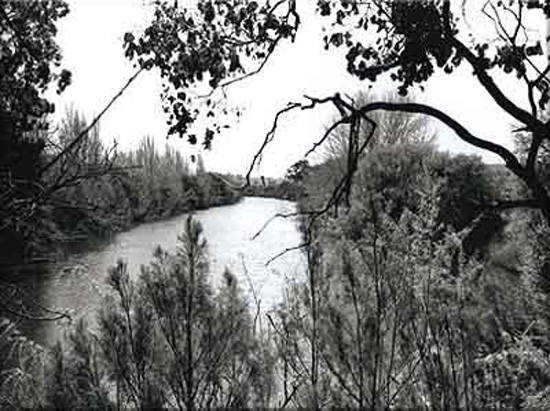
Some peaceful banks views a few miles up River from Thomas Henry's home.
Monday March 4 .. 72
Left home in Company of my mate for the purpose of geting the tools out of the Bush
at Lake Bunga having no more Work to do in that Direction at
my mate proceeded home With the tools and I proceeded to the Lake entrance Workes to optain a Setelment
Stoped all Monday night at the entrance
acounts not arranged as yet
} 4 / 3 / 72
From this comment, John Carpenter must have had an office / temporary dwelling at the New Works construction site. A few days seems to be a substantial wait to settle the accounts and Thomas Henry's final pay settlement.
Teausday March 5 / 72
Still at entrance not having arranged acounting as yet and I am Sufering
Veary bad from the Efects of Bowell Complaint
5 / 3 / 72
Wensday March 6 .. 72
Still at the entrance having only just optained a Setelment arose
Starting home this evening
Dont feel Veary Well as yet
Veary Weak indeed.
Left Jimmes point about 3 p.m. for arriving at Dusk
all Right at home
feel a Little Better
6 / 3 / 72
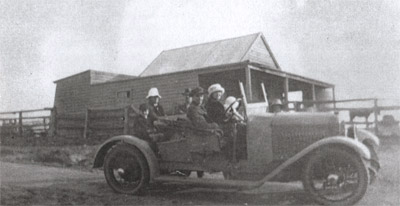
Visitors often called in, when he was at home too eg. The O'Shea relations
from Walhalla in front of Thomas Henry's cheese factory. Circa 1910 here.
Courtesy - Jack Cunningham.
N.B. At this stage in the proceedings and flow, the diary remnants to hand, take a huge leap in time, a period of some ten months, to early days in the following year of 1873. We find Thomas Henry still networking his contacts in the milling industry, but has found it necessary to travel even further afield to the Nowa Nowa district to find work.
Sunday January 26 1873
Left home This morning for Jimmys point for the pupose of optaining Work
called at mr Vavasures
had Dinner and is moving
Stoping hear for the night
I have taken my horse up to mr Howellet to leave him as I am going to Lake Tyers to morrow
With mr Vaversure in Scherche of timber
no eventes of any more note
One would imagine Thomas Henry had a strong and trusting friendship with "Mr Howelett" who was actually from Jemmies Point which overlooks Lakes Entrance, as his horse in these days, would have been his most valuable possession next to his farm and house. Having only a surname to research, it has not possible to determine if Thomas Henry's acquaintance was either of two local brothers, Henry and Joseph Howlett. According to Henry's Death notice of 1916, these two brothers arrived in the district in 1864 from Tasmania, and worked as farm hands and shearers for about 3 years before they had land at Jemmies Point, and later on the Tambo River and Johnsonville.

Henry ( Harry ) Howlett - Courtesy Ancestry.com
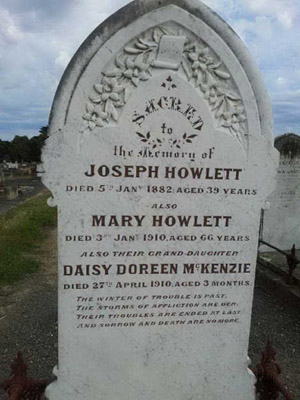
Headstone of Joseph Howlett and wife Mary McKinnon - Courtesy Ancestry.com
According to Ancestry researchers, both Henry and Joseph married, both had large families, and were involved in local community development and Tambo Shire matters, as per following example.
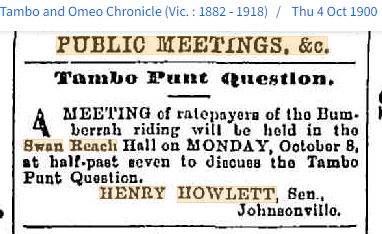
Public meeting called by Henry Howlett about a punt on the Tambo River 1900 - Courtesy Trove.
Well, I certainly hope Sarah Elizabeth Vavasseur cooked up a good tucker for Thomas Henry. Sarah and her husband John had their hands full, with three little ones to care for. John, from England originally, and Sarah ( nee Robinson ) had been married nearly four years by this time in the diary, and ended up having their eighth child Olive Ethel at Cunninghame, in 1885.
John had been involved in organising a couple of steamships, the Black Swan in particular, as part of a service between the Mitchell and Tambo Rivers around the mid 1860's. Almost five years after this encounter, he secured the first commercial fishing license furbished by the Colquhoun Parish. The Vavasseurs lived next door to the Howletts just up from Jemmys Point, where Thomas Henry Cunningham decided to leave his horse in good care, whilst away at Lake Tyers.
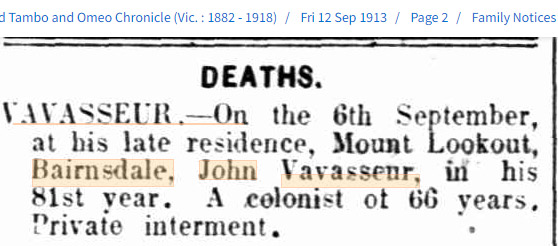
Death notice of John Vavvaseur in Bairnsdale, aged 81 in 1913.
Sadly John Vavasseur died at his residence of Mt. Lookout in Bairnsdale in Sep 1913, aged 81, and left his wife Sarah Annie, to fend for his local interests and property at Wy Yung.
Monday January 27 .. 1873
Left mr Vavershaws This morning enrout for Lake Tyers in Company of Hailles and Vaversure
The Day has been fine and I have enjoyed the Days Travelling
According to Ancestry.com John Vavasseur was born in Baintree in Essex England in 1833 to George and Ann Vavasseur, and he and his wife Sarah Elizabeth Robinson, had one son being Henry William Vavasseur born in 1874, and two daughters Emily in 1869 and Olive in 1884. John Vavasseur's obituary notice stated he passed away in Bairnsdale at his residence named Mount Lookout, and he was apparently regularly involved in the local timber industry. Sarah passed away in her home in Frances St Bairnsdale in Nov 1929.
"Hailles" noted on this Monday, has been interpreted from Thomas Henry's handwriting as probably being Lewis Hallier, who was recruited as a teacher at Rev. Bulmer's school at the Lake Tyers Station in 1874. A house was especially built to accommodate Lewis and his wife, on the property. Later electoral rolls list Lewis as a grazier at Nicholson.
Teausday January 28 .. 1873
Left Lake Tyers This morning
*** unreadable ***
for Nowa Nowa
*** unreadable ***
Lead ore
Stacked for Loading Down the Lakes to be Shipped on board the Steamer
I hear the ore is first Shipped about fifteen miles from the Black Station on Lake Tyers.
This ore is first packed on horses a Distance of about 20 miles to the head of one of the arms of Lake Tyers
making in all a Distance of 35 miles in all
and Then This ore is carted to Reeves River a Distance of 7 miles
Thus making in all 42 miles at a cost 3 pounds per ton
This concludes my Remarks for This Day
Wee are now camped for the night
on the Whole this place has a Veary Wild appearance
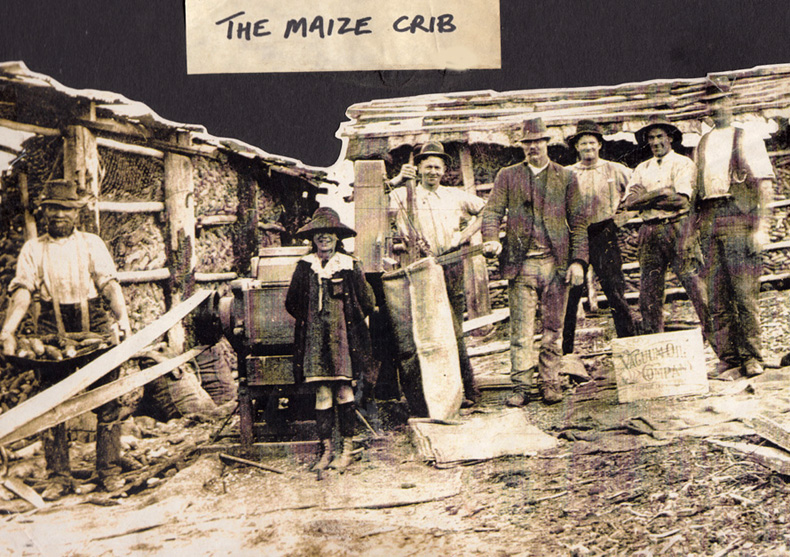
The Cunningham family have also been major maize growers from early days - Courtesy Jack Cunningham.
From left, Thomas Henry Cunningham Junior, his wife's neice Mary Kerrison, Robert Liddell Cunningham, friend George Chandler, William Clifford Cunningham, neighbour Albert Stone, and George Earnest Cunningham.
Unfortunately for the readers sake, the first portion of this entry had greatly deteriorated. As Thomas Henry's return trip the next day was by steamer, one could presume his journey to Nowa Nowa on the Monday, may have also been by the same mode of transportation. The "Black Station on Lake Tyers" referred to here would be the aboriginal mission that Reverend John Bulmer set up.
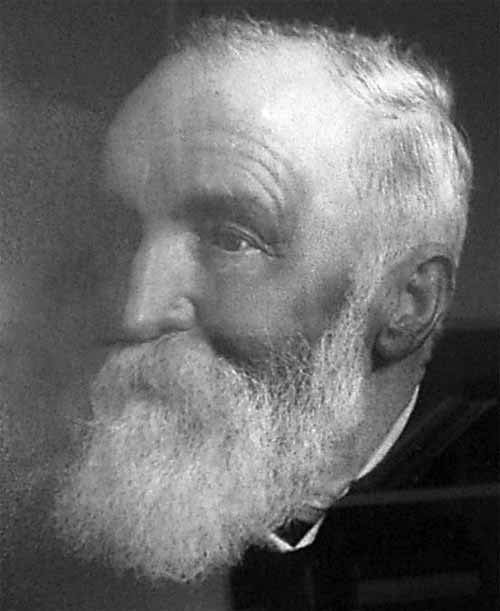
Rev John Bulmer - Courtesy Wikipedia.
According to Wikipedia, John Bulmer was born around 1833 in Durham, emigrated to Victoria in 1853, and worked as a carpenter for nearly three years, before he became heavily involved in the Church of England Aboriginal Mission program, initially on the Murray River at Yelta, and later at Lake Tyers around Aug in 1861. John married twice, firstly to Marion Stocks who died quite young in Melbourne, and Carolyn Blay who bore 8 sons and 2 daughters.
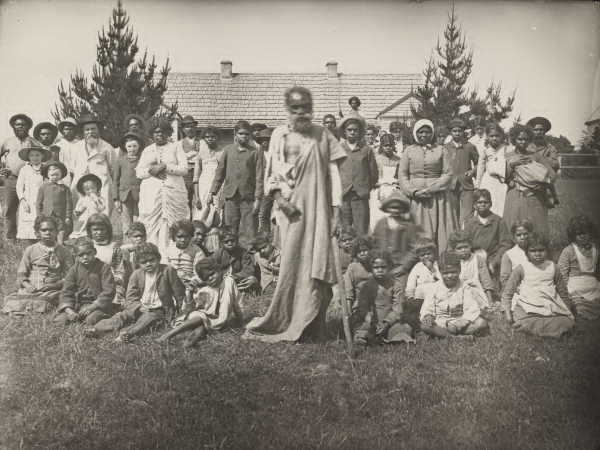
Residents of Lake Tyers Station - John Bulmer 4th from left at rear - Courtesy Wikipedia.
Wensday January 29 .. 1873
Left Nowa Nowa This morning at about 7 a.m. enrout for Lake Tyers
our boat being Loaded With ore
Wee proceeded some 7 miles Down but had to come to
*** unreadable ***
and Wait till the Wind
*** unreadable ***
Wensday January 5 .. 1873
Left home This Morning at 11 am enroute for Lake Tyers for the purpose of Splitting
Some Rails for Mr Douglash in exchange for some furniture
Arrived at his place at 1/2 past five
The Day has been fine
I am Stoping in Douglashes by My Self tonight.
Thursday Febuary 6 .. 1873
Went in Scheach of timber With mr Douglash
found some but of not of a Veary good kind Returned back to the Camp had Some Dinner and made a mall [ mallet ] and got my tools arranged for commencing Work Was allso over at mr
Bulmers Station
met Dick Graham Loading his Dray With Lead ore
The Day has been *** unreadable *** warm
" Douglash " as noted above, has a few unconfirmed options to consider. A Douglas family lived near Lindenow - another family of the same namesake were at Stratford in this era. There was also a Robert Dahgleish, who married and lived with a Nanny Stevens in the local proximity.
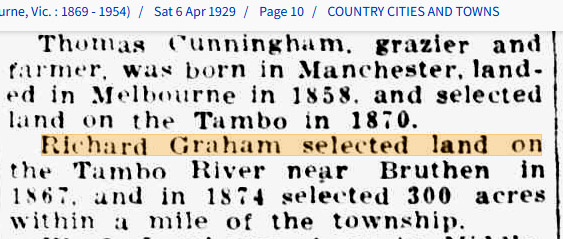
Cutting showing Thomas Henry Cunningham and Dick Graham were neighbours - Courtesy Trove.
Dick ( Richard Graham ) owned a farming property of some note on the outskirts of Bruthen, on the main road heading out of town. The old and now derelict railway line which looped inland from the Bumberrah railway station encompassing Mossiface and Bruthen, cut through Dick's allotment, heading South East. Also in a prime position, Dick acquired a second block in 1873, on the same side of the Tambo River as Sunny Hills, all but a fifteen minute stroll up from the busy little river port of Batten's Landing.
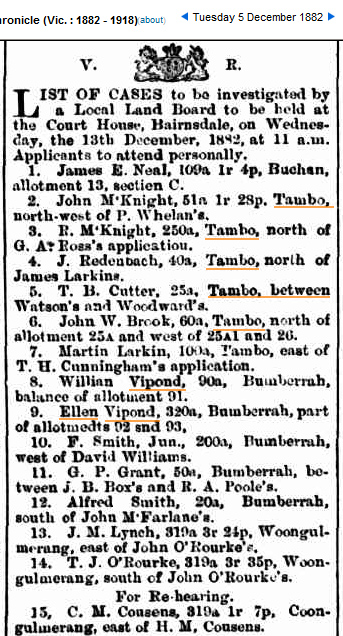
Land Selection cases, for Ellen Vipond, brother William Vipond, and brother-in-law Thomas Bell Cutter in 1882.
Your host's Great Grand father's sister in law, Maria Bell Vipond, married Dick Graham's downstream neighbour Thomas Cutter. Thomas Henry's Daughter in law, Mary Ellen Liddell, happened to be the niece of William Calvert ( Jnr ), whom reside along Dick's northern boundary line.
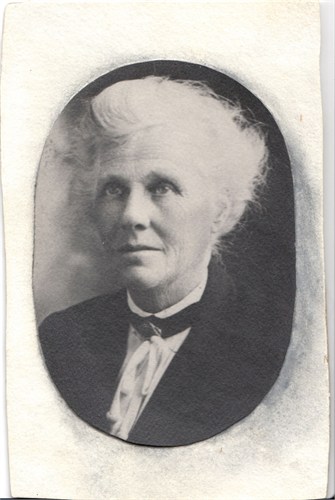
Ellen Vipond c1930 ~ Maria Bell's sister and your web host's great grandmother.
It is assumed the Vipond family were quite successful on the goldfields near Campbells Creek in the 1860s, as most of the Vipond children ended up owning small farms near the Swan Reach township by the early 1880s. For some unknown reason, the family in general had a major interest in education, via teaching and committee roles.
Ellen as pictured above, was the Seamstress teacher at Tambo Lower school, where she resigned in Sep 1885. Ellen Vipond's sister Margaret Ann Vipond was the first teacher ( half time )
at Swan Reach School, and she ended up marrying John Rowe, a school Truant Officer originally from the Castlemaine district. Ellen's Uncle John Vipond
was the headmaster at the Nicholson Primary School, which was basically a small bark hut, which was leased for the sum of 1 Shilling per year.
Friday Febuary 7 .. 1873
Started away in the Bush for the purpose commencing Work
fell a mountain ash tree and got Cross cut Ready for Spliting tomorrow
The proper quality of timber seems to be Veary scarce
I am camped by my self up one of The arms of Lake Tyers
it is Veary lonely
The only company is my Dog and gun
Thomas Henry must have been badly missing the company of his bushy mate Kelly during this spell in the bush. There is no mention of Kelly in any of these extracts noted for 1873.
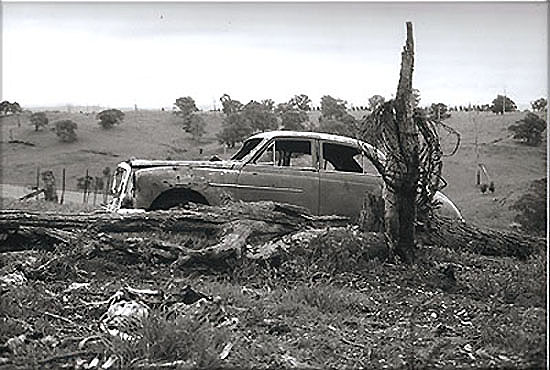
The view looking North East from Kelly's mud brick hut on Thomas Henry's farm.
Saterday Febuary 8 .. 1873
had to abandon The tree That I fell yesterday as I could not Split it being so Veary Tough
fell another one and I Split it up
Suceeded in optaining 50 Rails and fell another one Ready for Monday
my Saw is in Veary bad order
This concludes my Days Work
it *** unreadable *** from Dawn
Sunday Febuary 9 - 1873
Left my Camp enrout for The Blacks Station
mr Douglash took me over in his boate
had Dinner at mr Bullmers Brought over my Saw for The purpose of geting it put in order
Left the Station for my Camp about 2 p.m.
it Rained Veary heavy in a *** unreadable ***
I am at my Camp and Left my Dog over at The Blacks Station
Monday Febuary 10 .. 1873
Left my Camp This morning for mr Bullmers Station
arrived Thear at 6 a.m.
got my Saw Done and Returned
Mr Douglash put me over in The boate
only managed to Split 30 Rails This Day
The timber is Veary hard and tough
Weather Dull all Day
Tuesday Feb 11 - 1873
I am Still by myself in the Bush
Spliting Rails got over 83 Rails This Day
I have got no meate of any kind and Thear is no game That you can get to Shoot
in fact I have Let my gun go Rusty having nothing to Do With it
my Dog is getting Veary poor
Fancy letting your trusty firearm go rusty whilst out in the scrub mate. Thomas Henry possibly got caught in the rain a couple of days earlier. Well, if there is not much game about to hunt, your dog's crook, and you've had a rough trot splitting logs all day, one may be forgiven for lacking in time and motivation to look after their gun and saw.
Wensday Febuary 12 - 1873
Split fifty Rails *** unreadable *** and fell one tree Wich turned out a Veary bad Spliter
it being Veary hard to Burst up
I Worked Veary hard This Day
I am Still by my Self and has nothing but Bread and tea to Live apon
Weather Dull and Windy
Well, maybe Thomas Henry's last entry of this diary extract should leave us all with a few things to think about. The next time the power goes out, you can't visit the Cunningham Connection on-line, and have to hunt for candles in the dark, spare a wee thought to the hardships and battles our early pioneers had to go through, surviving sometimes on "nothing but Bread and tea".
===========================================================
Cunningham Connection Corner - Document Foot Notes.
Bit of a treat in store for those maybe pondering a better insight, maybe interested in checking out some other important historical perceptions of life according to Thomas Henry ~ in his own words and hand.
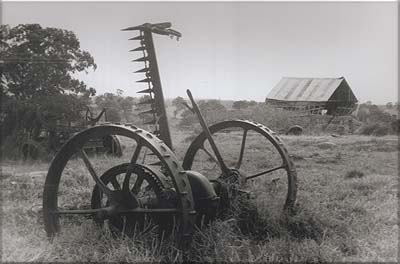
Thomas Henry's creamery cheese factory in 1995, which was demolished for homestead safety reasons, shortly into the current milenium.
You have already seen an earlier view of the cheese factory Thomas Henry actually set up in 1893. The original business and building was located in Bairnsdale, and had hard financial times, so the owner sold Thomas Henry the building in 1893. It was transported behind a large bullock team, crossing the rivers on the punts, not unlike the one pictured here.
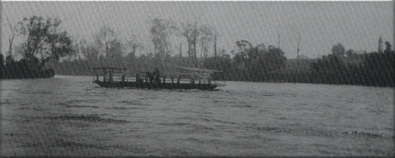
Punt crossing the Tambo River - Courtesy Jack Cunningham.
As tradition of the times often dictated, Thomas and Margaret's eldest daughter Cate Cunningham, became responsible for the running of the creamery in 1893 aged 24, and was in charge of making cheese, as per her handwitten cheese starter notes as shown here.
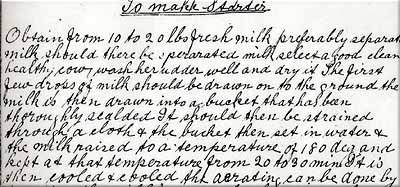
Cate Cunningham's cheese starter recipe of around the mid 1880s.
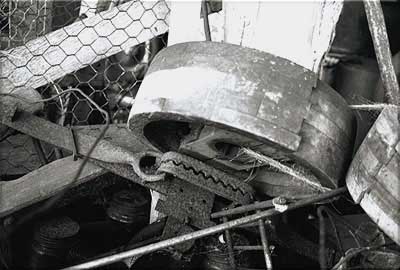
The two round wooden discs shown here are Separators purchased in 1893 - Courtesy Mixo Sydenham.
Family recollection also covers the point that the on farm produced and packaged butter and cheese, was regularly picked up by paddle steamer at what was known as Cunningham's Landing on the Tambo River near Schmalens Bluff, just north of the Sunny Hills property. It is possible the PS Enterprise as show above, picked up Cate's cheese for sale and distribution in Bairnsdale, and dropped of much needed food and supplies in return, for Thomas Henry and Margaret and their 10 children.
The cream separators were in very good condition being about 102 years old when the above photo was taken.
Account of set up items purchased, in 1893.
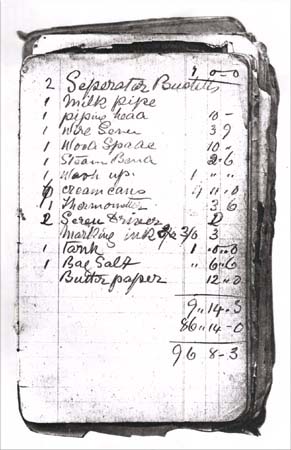
Thomas Henry's purchase list of items for his Creamery in 1893.
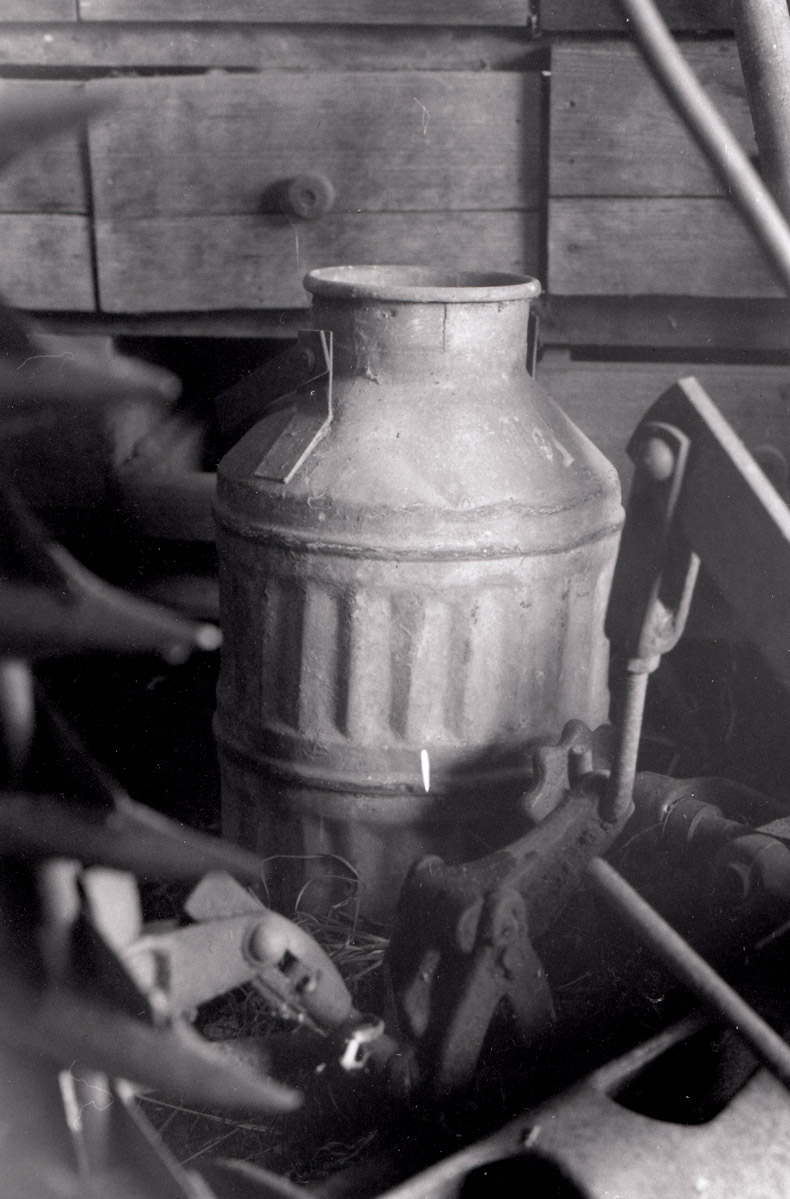
The only known existing one of six heavy cream cans Thomas Henry ordered in 1893 as per his above diary list.
===========================================================
For further info regarding Thomas Henry Cunningham's relations, primarily resulting from the marriage of his third daughter Sarah Ann to William ( Bill ) Coulson Calvert Liddell in 1894, as well as the marriage of their daughter Sarah Ann ( Annie ) Liddell to John Victor ( Jack ) Richardson in 1922, kindly choose from the following family options.

Back to Site Index.

From Joseph Richardson born 1721 at Alston, U.K.

From John Richardson's descendants born in Australia.

From John Allison born in 1801, Alston U.K.

From John Armstrong born in 1705, Haltwhistle U.K.

From Thomas Bell born 1806 of Allendale, U.K.

From James Broadwood born 1796 of Northumberland, U.K.

From William Calvert born 1791 at Kirkhaugh, U.K.

From John Clementson born 1692 in Garrigill, U.K.

From William Coulson born 1760 in Cumberland, U.K.

From Robert Cochrane born 1778 in Eglington, U.K.

From Edward Hewitson born 1794 in Kirk Linton, U.K.

From Edward Hewitson born 1794 in Kirk Linton, U.K.

From Joseph Parker born 1810 at Allendale, U.K.

From James Rowe born 1765 in Cornwall, U.K.

From Nicholas Vipond born 1655 in Alston, U.K.